Develop a Project Portfolio Management Strategy

- As an IT leader, you oversee a project environment in which the organizational demand for new products, services, and enhancements far outweighs IT’s resource capacity to adequately deliver on everything.
- As a result, project throughput suffers. IT starts a lot of projects, but has constant difficulties delivering the bulk of them on time, on budget, in scope, and of high quality. What’s more, many of the projects that consume IT’s time are of questionable value to the business.
- You need a project portfolio management (PPM) strategy to help bring order to IT’s project activity. With the right PPM strategy, you can ensure that you’re driving the throughput of the best projects and maximizing stakeholder satisfaction with IT.
Our Advice
Critical Insight
- IT leaders commonly conflate PPM and project management, falsely believing that they already have a PPM strategy via their project management playbook. While the tactical focus of project management can help ensure that individual projects are effectively planned, executed, and closed, it is no supplement for the insight into “the big picture” that a PPM strategy can provide.
- Many organizations falter at PPM by mistaking a set of processes for a strategy. While processes are no doubt important, without an end in mind – such as that provided by a deliberate strategy – they inevitably devolve into inertia or confusion.
- Executive layer buy-in is a critical prerequisite for the success of a PPM strategy. Without it, any efforts to reconcile supply and demand, and improve the strategic value of IT’s project activity, could be quashed by irresponsible, non-compliant stakeholders.
Impact and Result
- Manage the portfolio as more than just the sum of its parts. Create a coherent strategy to maximize the sum of values that projects deliver as a whole – as a project portfolio, rather than a collection of individual projects.
- Get to value early. Info-Tech’s methodology tackles one of PPM’s most pressing challenges upfront by helping you to articulate a strategy and get executive buy-in for it before you define your process goals. When senior management understands why a PPM strategy is necessary and of value to them, the path to implementation is much more stable.
- Create PPM processes you can sustain. Translate your PPM strategy into specific, tangible near-term and long-term goals, which are realized through a suite of project portfolio management processes tailored to your organization and its culture.
Develop a Project Portfolio Management Strategy Research & Tools
Start here – read the Executive Brief
Read our concise Executive Brief to find out why you should develop a project portfolio management strategy, review Info-Tech’s methodology, and understand the four ways we can support you in completing this project.Besides the small introduction, subscribers and consulting clients within this management domain have access to:
- Develop a Project Portfolio Management Strategy – Executive Brief
- Develop a Project Portfolio Management Strategy – Phases 1-3
1. Get executive buy-in for your PPM strategy
Choose the right PPM strategy for your organization and get executive buy-in before you start to set PPM process goals.
- Develop a Project Portfolio Management Strategy – Phase 1: Get Executive Buy-In for Your PPM Strategy
- PPM High-Level Supply-Demand Calculator
- PPM Strategic Plan Template
- PPM Strategy-Process Goals Translation Matrix Template
2. Align PPM processes to your strategic goals
Use the advice and tools in this phase to align the PPM processes that make up the infrastructure around projects with your new PPM strategy.
- Develop a Project Portfolio Management Strategy – Phase 2: Align PPM Processes to Your Strategic Goals
- PPM Strategy Development Tool
3. Complete your PPM strategic plan
Refine your PPM strategic plan with inputs from the previous phases by adding a cost-benefit analysis and PPM tool recommendation.
- Develop a Project Portfolio Management Strategy – Phase 3: Complete Your PPM Strategic Plan
- Project Portfolio Analyst / PMO Analyst
Workshop: Develop a Project Portfolio Management Strategy
Workshops offer an easy way to accelerate your project. If you are unable to do the project yourself, and a Guided Implementation isn't enough, we offer low-cost delivery of our project workshops. We take you through every phase of your project and ensure that you have a roadmap in place to complete your project successfully.
1 Get Executive Buy-In for Your PPM Strategy
The Purpose
Choose the right PPM strategy for your organization and ensure executive buy-in.
Set process goals to address PPM strategic expectations and steer the PPM strategic plan.
Key Benefits Achieved
A right-sized PPM strategy complete with executive buy-in for it.
A prioritized list of PPM process goals.
Activities
1.1 Assess leadership mandate.
1.2 Determine potential resource capacity.
1.3 Create a project inventory.
1.4 Prepare to communicate your PPM strategy to key stakeholders.
1.5 Translate each strategic goal into process goals.
1.6 Set metrics and preliminary targets for PPM process goals.
Outputs
Choice of PPM strategy and the leadership mandate
Analysis of current project capacity
Analysis of current project demand
PPM Strategic Plan – Executive Brief
PPM strategy-aligned process goals
Metrics and long-term targets for PPM process goals
2 Align PPM Processes to Your Strategic Goals
The Purpose
Examine your current-state PPM processes and create a high-level description of the target-state process for each of the five PPM processes within Info-Tech’s PPM framework.
Build a sound business case for implementing the new PPM strategy by documenting roles and responsibilities for key PPM activities as well as the time costs associated with them.
Key Benefits Achieved
Near-term and long-term goals as well as an organizationally specific wireframe for your PPM processes.
Time cost assumptions for your proposed processes to ensure sustainability.
Activities
2.1 Develop and refine the project intake, prioritization, and approval process.
2.2 Develop and refine the resource management process.
2.3 Develop and refine the portfolio reporting process.
2.4 Develop and refine the project closure process
2.5 Develop and refine the benefits realization process.
Outputs
Process capability level
Current-state PPM process description
Retrospective examination of the current-state PPM process
Action items to achieve the target states
Time cost of the process at current and target states
3 Complete Your PPM Strategic Plan
The Purpose
Perform a PPM tool analysis in order to determine the right tool to support your processes.
Estimate the total cost-in-use of managing the project portfolio, as well as the estimated benefits of an optimized PPM strategy.
Key Benefits Achieved
A right-sized tool selection to help support your PPM strategy.
A PPM strategy cost-benefit analysis.
Activities
3.1 Right-size the PPM tools for your processes.
3.2 Conduct a cost-benefit analysis of implementing the new PPM strategy.
3.3 Define roles and responsibilities for the new processes.
3.4 Refine and consolidate the near-term action items into a cohesive plan.
Outputs
Recommendation for a PPM tool
Cost-benefit analysis
Roles and responsibilities matrix for each PPM process
An implementation timeline for your PPM strategy
Further reading
Develop a Project Portfolio Management Strategy
Drive IT project throughput by throttling resource capacity.
Analyst Perspective
“Tactics without strategy is the noise before defeat.” – Sun Tzŭ
"Organizations typically come to project portfolio management (PPM) with at least one of two misconceptions: (1) that PPM is synonymous with project management and (2) that a collection of PPM processes constitutes a PPM strategy.
Both foundations are faulty: project management and PPM are separate disciplines with distinct goals and processes, and a set of processes do not comprise a strategy – they should flow from a strategy, not precede one. When built upon these foundations, the benefits of PPM go unrealized, as the means (i.e. project and portfolio processes) commonly eclipse the ends of a PPM strategy – e.g. a portfolio better aligned with business goals, improved project throughput, increased stakeholder satisfaction, and so on.
Start with the end in mind: articulate a PPM strategy that is truly project portfolio in nature, i.e. focused on the whole portfolio and not just the individual parts. Then, let your PPM strategy guide your process goals and help to drive successful outcomes, project after project." (Barry Cousins, Senior Director of Research, PMO Practice, Info-Tech Research Group)
Our understanding of the problem
This Research Is Designed For:
- CIOs who want to maximize IT’s fulfillment of both business strategic goals and operational needs.
- CIOs who want to better manage the business and project sponsors’ expectations and satisfaction.
- CIOs, PMO directors, and portfolio managers who want a strategy to set the best projects for the highest chance of success.
This Research Will Help You:
- Get C-level buy-in on a strategy for managing the project portfolio and clarify their expectations on how it should be managed.
- Draft strategy-aligned, high-level project portfolio management process description.
- Put together a strategic plan for improving PPM processes to reclaim wasted project capacity and increase business satisfaction of IT.
This Research Will Also Assist:
- Steering committee and C-suite management who want to maximize IT’s value to business.
- Project sponsors who seek clarity and fairness on pushing their projects through a myriad of priorities and objectives.
- CIOs, PMO directors, and portfolio managers who want to enable data-driven decisions from the portfolio owners.
This Research Will Help Them:
- Optimize IT’s added value to the business through project delivery.
- Provide clarity on how IT’s project portfolio should be managed and the expectations for its management.
- Improve project portfolio visibility by making trustworthy project portfolio data available, with which to steer the portfolio.
Executive Summary
Situation
- As CIO, there are too many projects and not enough resource capacity to deliver projects on time, on budget, and in scope with high quality.
- Prioritizing projects against one another is difficult in the face of conflicting priorities and agenda; therefore, projects with dubious value/benefits consume resource capacity.
Complication
- Not all IT projects carry a direct value to business; IT is accountable for keeping the lights on and it consumes a significant amount of resources.
- Business and project sponsors approve projects without considering the scarcity of resource capacity and are frustrated when the projects fail to deliver or linger in the backlog.
Resolution
- Create a coherent strategy to maximize the total value that projects deliver as a whole portfolio, rather than a collection of individual projects.
- Ensure that the steering committee or senior executive layer buys into the strategy by helping them understand why the said strategy is necessary, and more importantly, why the strategy is valuable to them.
- Translate the strategic expectations to specific, tangible goals, which are realized through a suite of project portfolio management processes tailored to your organization and its culture.
- Putting into place people, processes, and tools that are sustainable and manageable, plus a communication strategy to maintain the stakeholder buy-in.
Info-Tech Insight
- Time is money; therefore, the portfolio manager is an accountant of time. It is the portfolio manager’s responsibility to provide the project portfolio owners with reliable data and close the loop on portfolio decisions.
- Business satisfaction is driven by delivering projects that align to and maximize business value. Use Info-Tech’s method for developing a PPM strategy and synchronize its definition of “best projects” with yours.
Projects that deliver on strategic goals of the business is the #1 driver of business satisfaction for IT
Info-Tech’s CIO Business Vision Survey (N=21,367) has identified a direct correlation between IT project success and overall business satisfaction with IT.
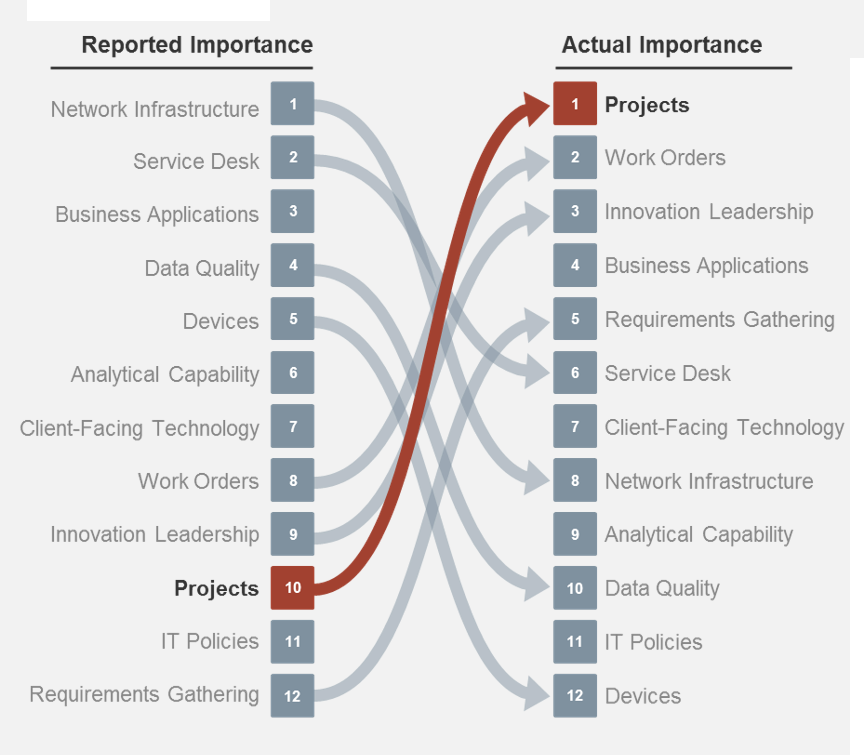
Reported Importance: Initially, when CIOs were asked to rank the importance of IT services, respondents ranked “projects” low on the list – 10 out of a possible 12.
Actual Importance: Despite this low “reported importance,” of those organizations that were “satisfied” to “fully satisfied” with IT, the service that had the strongest correlation to high business satisfaction was “projects,” i.e. IT’s ability to help plan, support, and execute projects and initiatives that help the business achieve its strategic goals.
On average, executives perceive IT as being poorly aligned with business strategy
Info-Tech’s CIO Business Vision Survey data highlights the importance of IT projects in supporting the business achieve its strategic goals. However, Info-Tech’s CEO-CIO Alignment Survey (N=124) data indicates that CEOs perceive IT to be poorly aligned to business’ strategic goals:
- 43% of CEOs believe that business goals are going unsupported by IT.
- 60% of CEOs believe that improvement is required around IT’s understanding of business goals.
- 80% of CIOs/CEOs are misaligned on the target role for IT.
- 30% of business stakeholders* are supporters of their IT departments. (Source: Info-Tech CIO/CEO Alignment Diagnostics, * N=32,536)
Efforts to deliver on projects are largely hampered by causes of project failure outside a project manager’s control
The most recent data from the Project Management Institute (PMI) shows that more projects are meeting their original goals and business intent and less projects are being deemed failures. However, at the same time, more projects are experiencing scope creep. Scope creeps result in schedule and cost overrun, which result in dissatisfied project sponsors, stakeholders, and project workers.
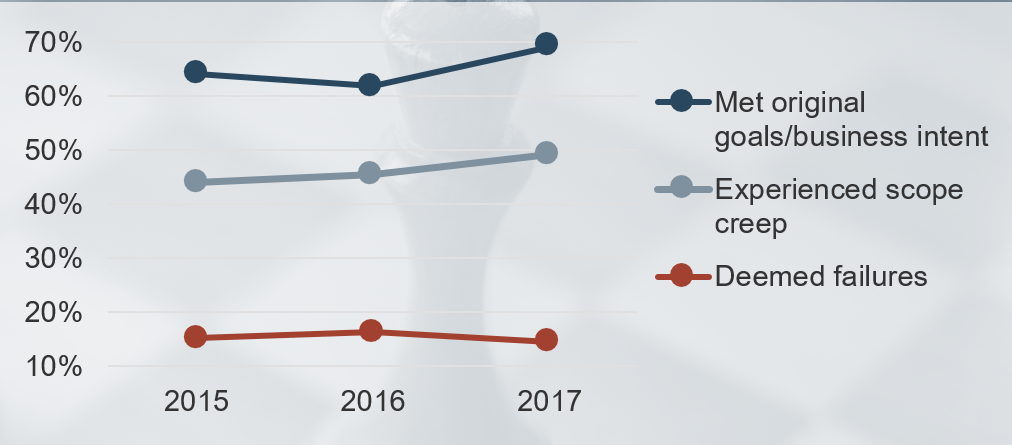
Meanwhile, the primary causes of project failures remain largely unchanged. Interestingly, most of these primary causes can be traced to sources outside of a project manager’s control, either entirely or in part. As a result, project management tactics and processes are limited in adequately addressing them.
| Relative rank | ||||
Primary cause of project failure |
2015 |
2016 |
2017 |
Trend |
| Change in organization's priorities | 1st | 1st | 1st | Stable |
| Inaccurate requirements gathering | 2nd | 3rd | 2nd | Stable |
| Change in project objectives | 3rd | 2nd | 3rd | Stable |
| Inadequate vision/goal for project | 6th | 5th | 4th | Rising |
| Inadequate/poor communication | 5th | 7th | 5th | Stable |
| Poor change management | 11th | 9th | 6th | Rising |
Project portfolio management (PPM) can improve business alignment of projects and reduce chance of project failure
PPM is about “doing the right things.”
The PMI describes PPM as:Interrelated organizational processes by which an organization evaluates, selects, prioritizes, and allocates its limited internal resources to best accomplish organizational strategies consistent with its vision, mission, and values. (PMI, Standard for Portfolio Management, 3rd ed.)
Selecting and prioritizing projects with the strongest alignment to business strategy goals and ensuring that resources are properly allocated to deliver them, enable IT to:
- Improve business satisfaction and their perception of IT’s alignment with the business.
- Better engage the business and the project customers.
- Minimize the risk of project failure due to changing organizational/ project vision, goals, and objectives.
"In today’s competitive business environment, a portfolio management process improves the linkage between corporate strategy and the selection of the ‘right’ projects for investment. It also provides focus, helping to ensure the most efficient and effective use of available resources." (Lou Pack, PMP, Senior VP, ICF International (PMI, 2015))
PPM is a common area of shortcomings for IT, with much room for improvement
Info-Tech’s IT Management & Governance Survey (N=879) shows that PPM tends to be regarded as neither an effective nor an important process amongst IT organizations.

55% ... of IT organizations believe that their PPM processes are neither effective nor important.
21% ... of IT organizations reported having no one responsible or accountable for PPM.
62% ... of projects in organizations effective in PPM met/exceeded the expected ROI (PMI, 2015).
In addition to PPM’s benefits, improving PPM processes presents an opportunity for getting ahead of the curve in the industry.
Info-Tech’s methodology for developing a PPM strategy delivers extraordinary value, fast
Our methodology is designed to tackle your hardest challenge first to deliver the highest-value part of the deliverable. For developing a PPM strategy, the biggest challenge is to get the buy-in of the executive layer.
"Without senior management participation, PPM doesn’t work, and the organization is likely to end up with, or return to, a squeaky-wheel-gets-the-grease mindset for all those involved." (Mark Price Perry, Business Driven Project Portfolio Management)
In the first step of the blueprint, you will be guided through the following steps:
- Choose the right PPM strategy: driven by the executives, supported by management.
- Objectively assess your current project portfolio with minimal effort to build a case for the PPM strategy.
- Engage the executive layer to get the critical prerequisite of a PPM strategy: their buy-in.
A PPM strategic plan is the end deliverable of this blueprint. In the first step, download the pre-filled template with content that represents the most common case. Then, throughout the blueprint, customize with your data.
Use this blueprint to develop, or refine, a PPM strategy that works for your organization
Get buy-in for PPM strategy from decision makers.
Buy-in from the owners of project portfolio (Steering Committee, C-suite management, etc.) is a critical prerequisite for any PPM strategy. This blueprint will give you the tools and templates to help you make your case and win the buy-in of portfolio owners.
Connect strategic expectations to PPM process goals.
This blueprint offers a methodology to translate the broad aim of PPM to practical, tactical goals of the five core PPM processes, as well as how to measure the results. Our methodology is supported with industry-leading frameworks, best practices, and our insider research.
Develop your PPM processes.
This blueprint takes you through a series of steps to translate the process goals into a high-level process description, as well as a business case and a roadmap for implementing the new PPM processes.
Refine your PPM processes.
Our methodology is also equally as applicable for making your existing PPM processes better, and help you draft a roadmap for improvement with well-defined goals, roles, and responsibilities.
Info-Tech’s PPM model consists of five core processes
There are five core processes in Info-Tech’s thought model for PPM.
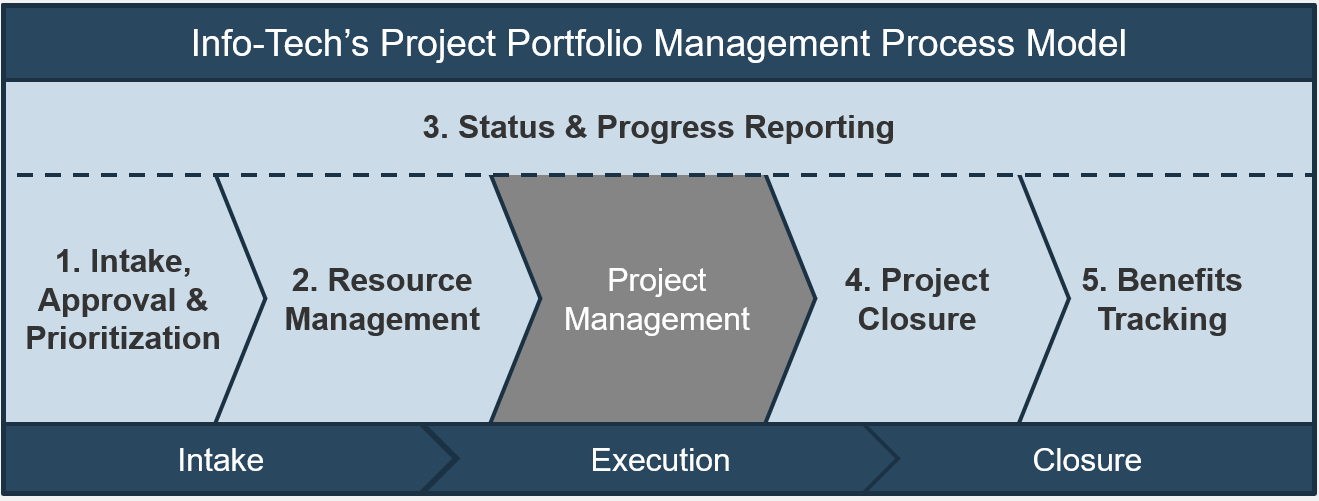
These processes create an infrastructure around projects, which aims to enable:
- Initiation of the “best” projects with the right resources and project information.
- Timely and trustworthy reporting to facilitate the flow of information for better decision making.
- Proper closure of projects, releasing resources, and managing benefits realization.
PPM has many moving pieces. To ensure that all of these processes work in harmony, you need a PPM strategy.
De-couple project management from PPM to break down complexity and create flexibility
Tailor project management (PM) processes to fit your projects.
Info-Tech’s PPM thought model enables you to manage your project portfolio independent of your PM methodology or capability. Projects interact with PPM via:
- A project charter that authorizes the use of resources and defines project benefits.
- Status reports that feed up-to-date, trustworthy data to your project portfolio.
- Acceptance of deliverables that enable proper project closure and benefits reporting.
Info-Tech’s PPM strategy is applicable whether you use Agile, waterfall, or anything in between for PM.
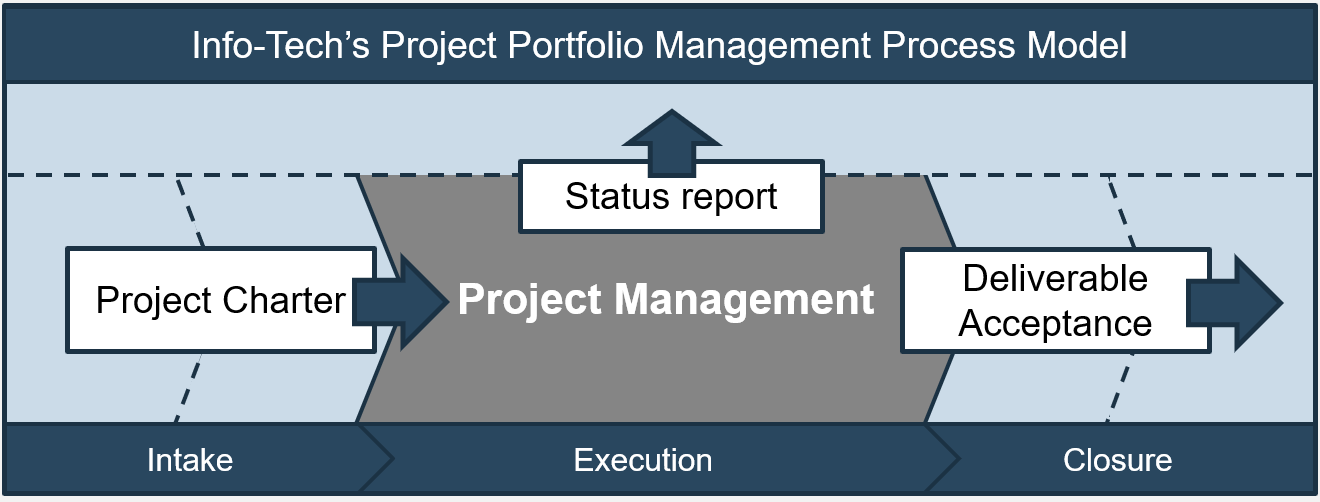
Learn about project management approach for small projects in Info-Tech’s Tailor PM Processes to Fit Your Projects blueprint.

Info-Tech’s approach to PPM is informed by industry best practices and rooted in practical insider research
Info-Tech uses PMI and ISACA frameworks for areas of this research.
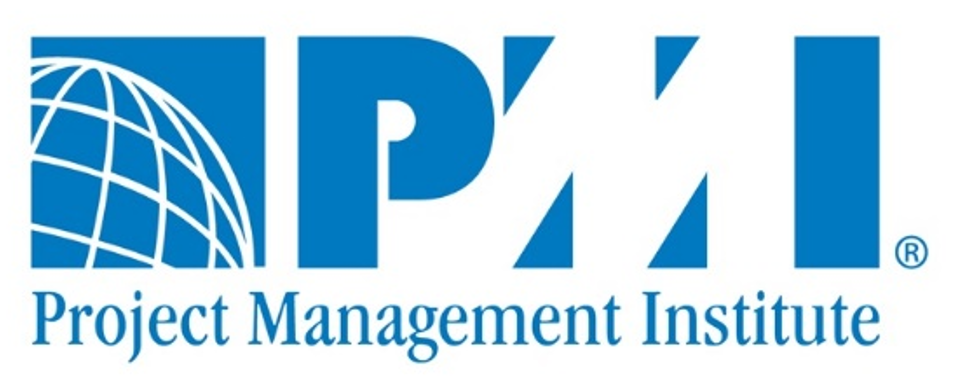 |
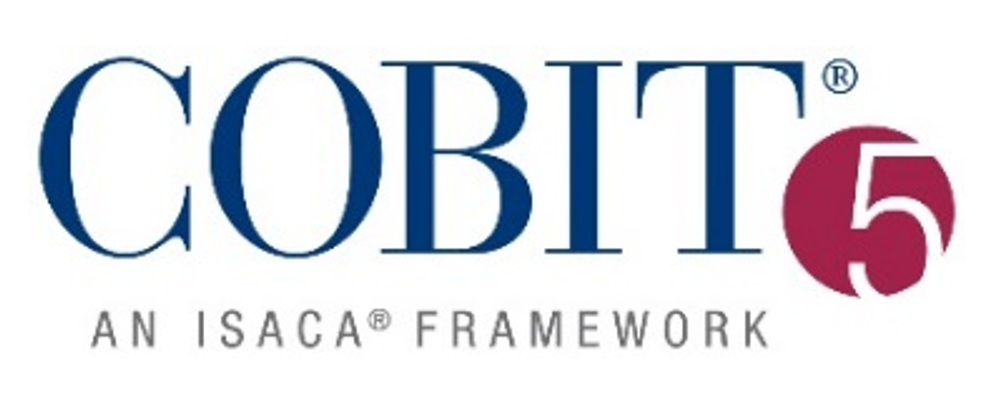 |
| PMI’s Standard for Portfolio Management, 3rd ed. is the leading industry framework, proving project portfolio management best practices and process guidelines. | COBIT 5 is the leading framework for the governance and management of enterprise IT. |
In addition to industry-leading frameworks, our best-practice approach is enhanced by the insights and guidance from our analysts, industry experts, and our clients.

33,000+ Our peer network of over 33,000 happy clients proves the effectiveness of our research.
1000+ Our team conducts 1,000+ hours of primary and secondary research to ensure that our approach is enhanced by best practices.
Re-position IT as the “facilitator of business projects” for PPM success
CASE STUDY
Industry: Construction
Source: Info-Tech Client
Chaos in the project portfolio
At first, there were no less than 14 teams of developers, each with their own methodologies and processes. Changes to projects were not managed. Only 35% of the projects were completed on time.
Business drives, IT facilitates
Anyone had the right to ask for something; however, converting ideas to a formal project demand required senior leadership within a business division getting on board with the idea.
The CIO and senior leadership decided that projects, previously assigned to IT, were to be owned and driven by the business, as the projects are undertaken to serve its needs and rarely IT’s own. The rest of the organization understood that the business, not IT, was accountable for prioritizing project work: IT was re-positioned as a facilitator of business projects. While it was a long process, the result speaks for itself: 75% of projects were now being completed on time.
Balancing the target mix of the project portfolio
What about maintaining and feeding the IT infrastructure? The CIO reserved 40% of IT project capacity for “keeping the lights on,” and 20% for reactive, unplanned activities, with an aim to lower this percentage. With the rest of the time, IT facilitated business projects
Three key drivers of project priority
- Does the project meet the overall company goals and objectives?
“If they don't, we must ask why we are bothering with it.” - Does the project address a regulatory or compliance need?
“Half of our business is heavily regulated. We must focus on it.” - Are there significant savings to be had?
“Not soft; hard savings. Can we demonstrate that, after implementing this, can we see good hard results? And, can we measure it?”
"Projects are dumped on IT, and the business abdicates responsibility. Flip that over, and say ‘that's your project’ and ‘how can we help you?’"
Use these icons to help direct you as you navigate this research
Use these icons to help guide you through each step of the blueprint and direct you to content related to the recommended activities.

This icon denotes a slide where a supporting Info-Tech tool or template will help you perform the activity or step associated with the slide. Refer to the supporting tool or template to get the best results and proceed to the next step of the project.

This icon denotes a slide with an associated activity. The activity can be performed either as part of your project or with the support of Info-Tech team members, who will come onsite to facilitate a workshop for your organization.
Info-Tech offers various levels of support to best suit your needs
DIY Toolkit |
Guided Implementation |
Workshop |
Consulting |
| "Our team has already made this critical project a priority, and we have the time and capability, but some guidance along the way would be helpful." | "Our team knows that we need to fix a process, but we need assistance to determine where to focus. Some check-ins along the way would help keep us on track." | "We need to hit the ground running and get this project kicked off immediately. Our team has the ability to take this over once we get a framework and strategy in place." | "Our team does not have the time or the knowledge to take this project on. We need assistance through the entirety of this project." |
Diagnostics and consistent frameworks used throughout all four options
Develop a PPM strategy – project overview
1. Get executive buy-in for your PPM strategy |
2. Align PPM processes to your strategic goals |
3. Complete your PPM strategic plan |
|
 Best-Practice Toolkit |
1.1 Choose the right PPM strategy for your organization 1.2 Translate PPM strategy expectations to specific process goals |
2.1 Develop and refine project intake, prioritization, and resource management processes 2.2 Develop and refine portfolio reporting, project closure, and benefits realization processes |
3.1 Select a right-sized PPM solution for supporting your new processes 3.2 Finalize customizing your PPM Strategic Plan Template |
Guided Implementations |
|
|
|
 Onsite Workshop |
Module 1:
Set strategic expectations and realistic goals for the PPM strategy |
Module 2:
Develop and refine strategy-aligned PPM processes |
Module 3:
Compose your PPM strategic plan |
Phase 1 Outcome:
|
Phase 2 Outcome:
|
Phase 3 Outcome:
|
Workshop overview
Contact your account representative or email Workshops@InfoTech.com for more information.
Workshop Day 1 |
Workshop Day 2 |
Workshop Day 3 |
Workshop Day 4 |
Workshop Day 5 |
|
| Get leadership buy-in for PPM strategy | Set PPM process goals and metrics with strategic expectations | Develop and Refine PPM processes | Develop and Refine PPM processes | Complete the PPM strategic plan | |
Activities |
|
|
|
|
|
Deliverables |
|
|
|
|
|
Develop a Project Portfolio Management Strategy
PHASE 1
Get Executive Buy-In for Your PPM Strategy
Phase 1 outline
Complete these steps on your own, or call us to complete a guided implementation. A guided implementation is a series of 2-3 advisory calls that help you execute each phase of a project. They are included in most advisory memberships.
Guided Implementation 1: Get executive buy-in for your PPM strategy
Proposed Time to Completion: 2 weeks
| Step 1.1: Choose the right PPM strategy | Step 1.2: Translate strategic expectations to process goals |
Start with an analyst kick-off call:
|
Work with an analyst to:
|
Then complete these activities…
|
Then complete these activities…
|
With these tools & templates:
|
With these tools & templates:
|
Phase 1 Results & Insights
|
|
Prepare to get to value early with step 1.1 of this blueprint
The first step of this blueprint will help you define your PPM strategy and get executive buy-in for it using section one of Info-Tech’s PPM Strategic Plan Template.
Where traditional models of consulting can take considerable amounts of time before delivering value to clients, Info-Tech’s methodology for developing a PPM strategy gets you to value fast.
In the first step of this blueprint, you will define your PPM strategy and prepare an executive presentation to get buy-in for the strategy. The presentation can be prepared in just a few hours.
- The activities in step 1.1 of this blueprint will help you customize the slides in section 1 of Info-Tech’s PPM Strategic Plan Template.
- Section one of the Template will then serve as your presentation document.
Once you have received buy-in for your PPM strategy, the remainder of this blueprint will help you customize section 2 of the Template.
- Section 2 of the Template will communicate:
- Your processes and process goals.
- Your near-term and long-term action items for implementing the strategy.
- Your PPM tool requirements.
- The costs and benefits of your PPM strategy.
Download Info-Tech’s PPM Strategic Plan Template.
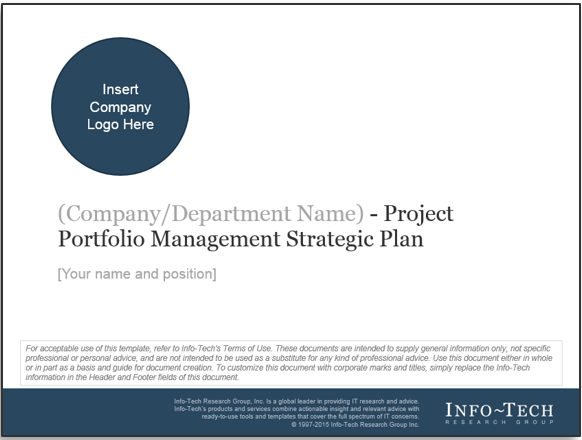
Step 1.1: Choose the right PPM strategy for your organization
PHASE 1 |
PHASE 2 |
PHASE 3 |
|||
| 1.1 | 1.2 | 2.1 | 2.2 | 3.1 | 3.2 |
| Choose the right PPM strategy | Translate strategy into process goals | Define intake & resource mgmt. processes | Define reporting, closure, & benefits mgmt. processes | Select a right-sized PPM solution | Finalize your PPM strategic plan |
This step will walk you through the following activities:
- Perform a leadership mandate survey.
- Choose your PPM strategy.
- Calculate your resource capacity for projects.
- Determine overall organizational demand for projects.
- Prepare an executive presentation of the PPM strategy.
This step involves the following participants:
- CIO
- PMO Director/Portfolio Manager
- Project Managers
- IT Managers
Outcomes of this step
- A PPM strategy
- A resource supply/project demand analysis
- An executive brief presentation
- Executive buy-in for the PPM strategy
“Too many projects, not enough resources” is the reality of most IT environments
In today’s organizations, the desires of business units for new products and enhancements, and the appetites of senior leadership to approve more and more projects for those products and services, far outstrips IT’s ability to realistically deliver on everything.
The vast majority of IT departments lack the resourcing to meet project demand – especially given the fact that day-to-day operational demands frequently trump project work.
As a result, project throughput suffers – and with it, IT's reputation within the organization.
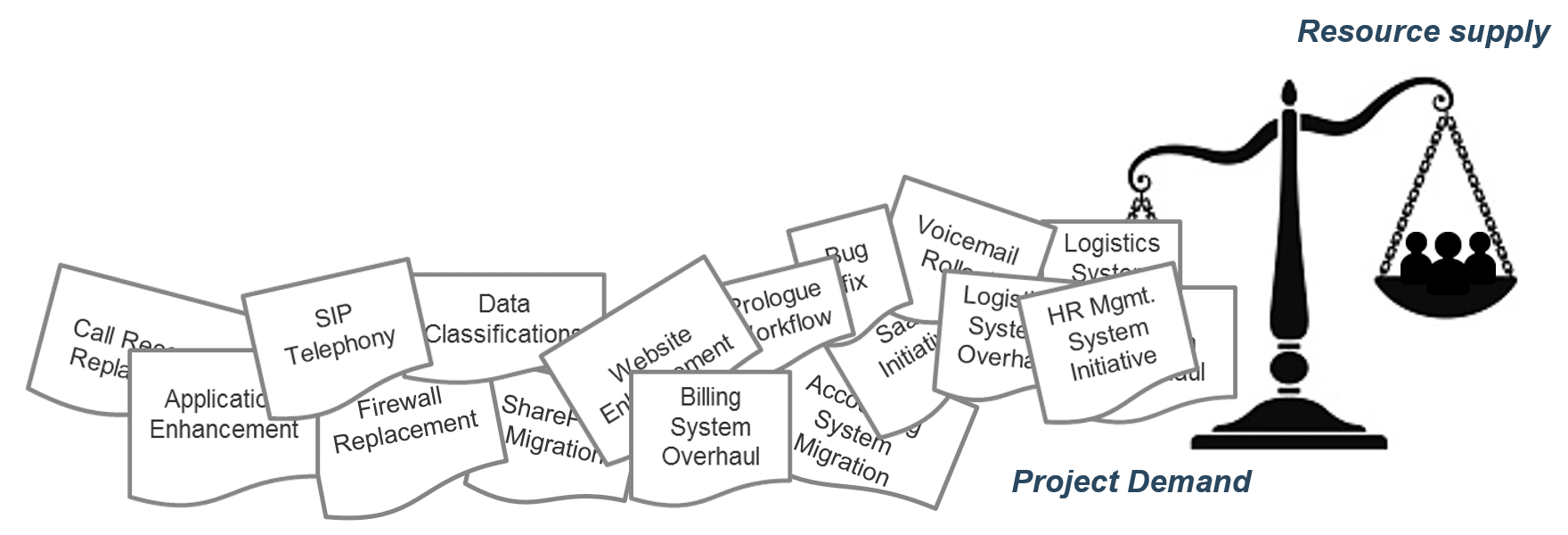
In these environments, a PPM strategy is required.
A PPM strategy should enable executive decision makers to make sense of the excess of demand and give IT the ability to prioritize those projects that are of the most strategic value to the business.
With the right PPM strategy, IT can improve project outcomes across its portfolio and drive business value – all while improving the workloads of IT project staff.
Info-Tech has two PPM strategy options that you can start to deploy today
This step will help you choose the most suitable option, depending on your project pain points and current level of executive engagement in actively steering the portfolio.
Option A: |
Option B: |
Goals of this approach:
|
Goals of this approach:
|
Who this approach is for:
|
Who this approach is for:
|
Each of these strategy options is driven by a set of specific strategic expectations to help communicate your PPM goals. See the following slides for an articulation of each strategy option.
A top-down, executive driven strategy is the optimal route, putting leadership in a position to best conduct the portfolio
Option A: Top-Down, Executive Driven Strategy
Strategic Expectations:
- Project Throughput: Maximize throughput of the best projects.
- Portfolio Visibility: Ensure visibility of current and pending projects.
- Portfolio Responsiveness: Make the portfolio responsive to executive steering when new projects and changing priorities need rapid action.
- Resource Utilization: Minimize resource waste and optimize the alignment of skills to assignments.
- Benefits Realization: Clarify accountability for post-project benefits attainment for each project, and facilitate the process of tracking/reporting those benefits.
Info-Tech Insight
Serve the executive with insight before you impede the projects with governance. This strategy option is where Info-Tech sees the most PPM success. A strategy focused at improving decision making at the executive layer will both improve project outcomes and help alleviate project workloads.
A bottom-up strategy can help project managers and teams succeed where insight into the big picture is lacking
Option B: Bottom-Up, Project Manager Driven Strategy
Strategic Expectations:
- Project Management Governance: All projects consuming IT resources will be continually validated in terms of best-practice process compliance.
- Project Risk Management: Identify risks and related mitigation approaches for all high-risk areas.
- Stakeholder Management: Ensure that project stakeholders are identified and involved.
- Project Manager Resourcing: Provide project managers as needed.
- Project-Level Visibility: Provide access to the details of project management processes (planning and progress) as needed.
Info-Tech Insight
Right-size governance to maximize success. Project management and governance success don’t necessarily equal project success. Project management processes should be a means to an end (i.e. successful project outcomes), and not an end in themselves. Ensure the ends justify the means.
Most recurring project challenges require a top-down portfolio management approach
While project management is a key ingredient to project success, tying to solve endemic project problems with project management alone won’t improve results over the long term.
Why Top-Down is a better starting point than Bottom-Up.
The most common IT project problems – schedule and budget overruns, scope creep, and poor quality – can ultimately, in the vast majority of cases, be traced back to bad decisions made at the portfolio level:
- The wrong projects get greenlighted.
- Shifting leadership priorities and operational demands make project plans and estimated delivery dates obsolete from the start.
- Too many projects get approved when there are not enough resources to effectively work on them all.
No amount of project management rigor can help alleviate these common root causes of project failure.
With a top-down PPM strategy, however, you can make sure that leadership is informed and engaged in making the right project decisions and that project managers and teams are situated for success.
"There is nothing so useless as doing efficiently that which should not be done at all." (Peter Drucker (quoted in Lessing))
Info-Tech Insight
Get Strategic About Project Success.
The difference between project management and project portfolio management comes down to doing things right vs. doing the right things. Both are important, no doubt; but doing the wrong things well doesn’t provide much value to the business in the long run.
Get insight into the big picture with a top-down strategy before imposing more administrative overhead on project managers and leads.
Perform a leadership mandate assessment to gauge executive needs and expectations
INPUT: Leadership expectations for portfolio and project management.
OUTPUT: Leadership mandate bar chart
Materials: Tab 6 of Info-Tech’s PPM High-Level Supply-Demand Calculator
Participants: Portfolio manager (or equivalent), PPM strategy sponsor(s), CIO and other members of senior management
Before choosing your strategy option, survey the organization’s leadership to assess what they’re expecting from the PPM strategy.
Use the “Leadership Mandate Survey” (located on tab 6 of Info-Tech’s PPM High-Level Supply-Demand Calculator) to assess the degree to which your leadership expects the PPM strategy to provide outcomes across the following capabilities: portfolio reporting, project governance, and project management.
- Deploy the 12-question survey via individual one-on-one meetings or group working sessions with your boss (the PPM strategy sponsor) as well as with the CIO and other senior managers from within IT and the business.
- If you cannot connect with the executive layer for this survey, do your best to estimate their responses to complete the survey.
- The survey should help distinguish if executives are looking for portfolio management or project management. It should be one input that informs your choice of strategy option A or B.
- If leadership is looking primarily for project management, you should proceed to Info-Tech’s Tailor Project Management Processes that Fit Your Projects blueprint.
Refer to the next slide for assistance analyzing the outputs in tab 6 and using them to inform your choice of strategy.
How to make use of the results of the leadership survey
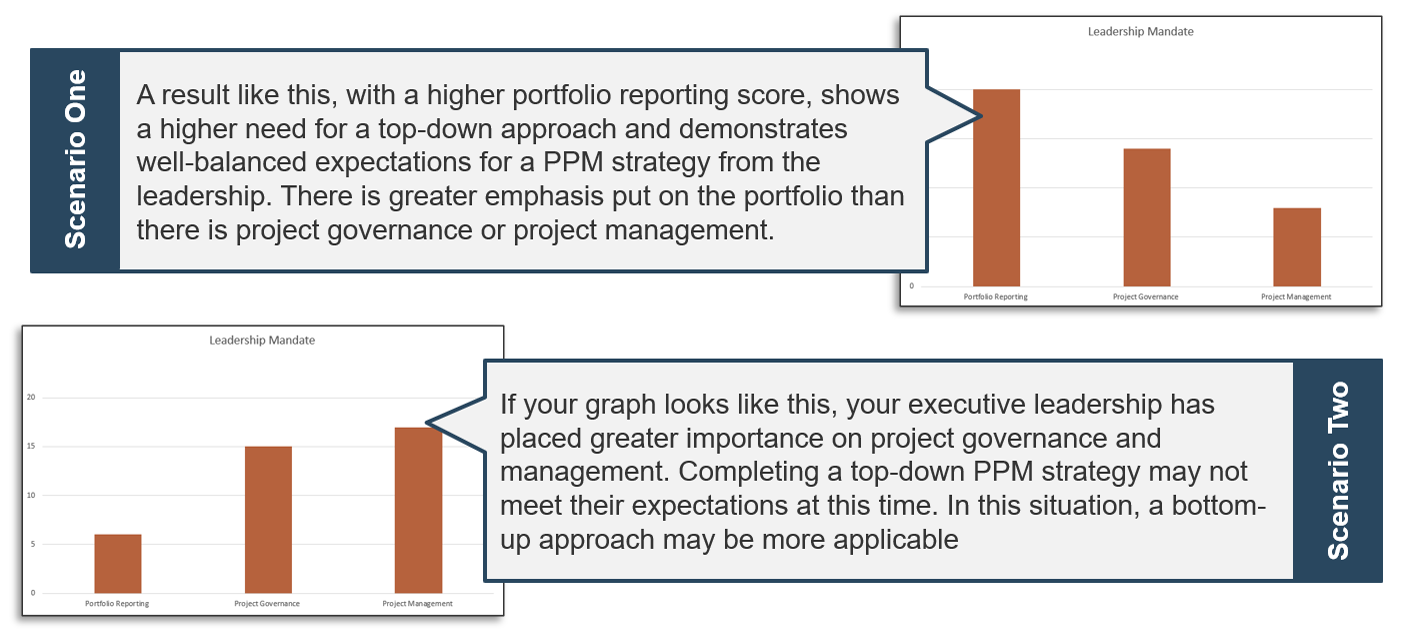
Customize Info-Tech’s PPM Strategic Plan Template. Insert screenshots of the survey and the bar graph from tab 6 of the PPM High-Level Supply-Demand Calculator onto slides 7 and 8, “PPM Strategy Leadership Mandate,” of the PPM Strategic Plan Template.
Proceed with the right PPM strategy for your organization
Based upon the results of the “Leadership Mandate Survey,” and your assessment of each strategy option as described in the previous slides, choose the strategy option that is right for your IT department/PMO at this time.
"Without a strategic methodology, project portfolio planning is frustrating and has little chance of achieving exceptional business success." (G Wahl (quoted in Merkhofer))
Option A:
Those proceeding with Option A should continue with remainder of this blueprint. Update your strategy statement on slide 3 of your PPM Strategic Plan Template to reflect your choice
Option B:
Those proceeding with Option B should exit this blueprint and refer to Info-Tech’s Tailor Project Management Processes to Fit Your Projects blueprint to help define a project management standard operating procedure.
Customize Info-Tech’s PPM Strategic Plan Template. If you’re proceeding with Option A, update slide 4, “Project Portfolio Management Strategy,” of your PPM Strategic Plan Template to reflect your choice of PPM strategy. If you’re proceeding with Option B, you may want to include your strategy statement in your Project Management SOP Template.
The success of your top-down strategy will hinge on the quality of your capacity awareness and resource utilization
A PPM strategy should facilitate alignment between project demand with resource supply. Use Info-Tech’s PPM High-Level Supply/Demand Calculator as a step towards this alignment.
Info-Tech’s research shows that the ability to provide a centralized view of IT’s capacity for projects is one of the top PPM capabilities that contributes to overall project success.
Accurate and reliable forecasts into IT’s capacity, coupled with an engaged executive layer making project approval and prioritization decisions based upon that capacity data, is the hallmark of an effective top-down PPM strategy.
- Use Info-Tech’s PPM High-Level Supply/Demand Calculator to help improve visibility (and with it, organizational understanding) into project demand and IT resource supply.
- The Calculator will help you determine IT’s actual capacity for projects and analyze organizational demand by taking an inventory of active and backlog projects.
Download Info-Tech’s PPM High-Level Supply/Demand Calculator.
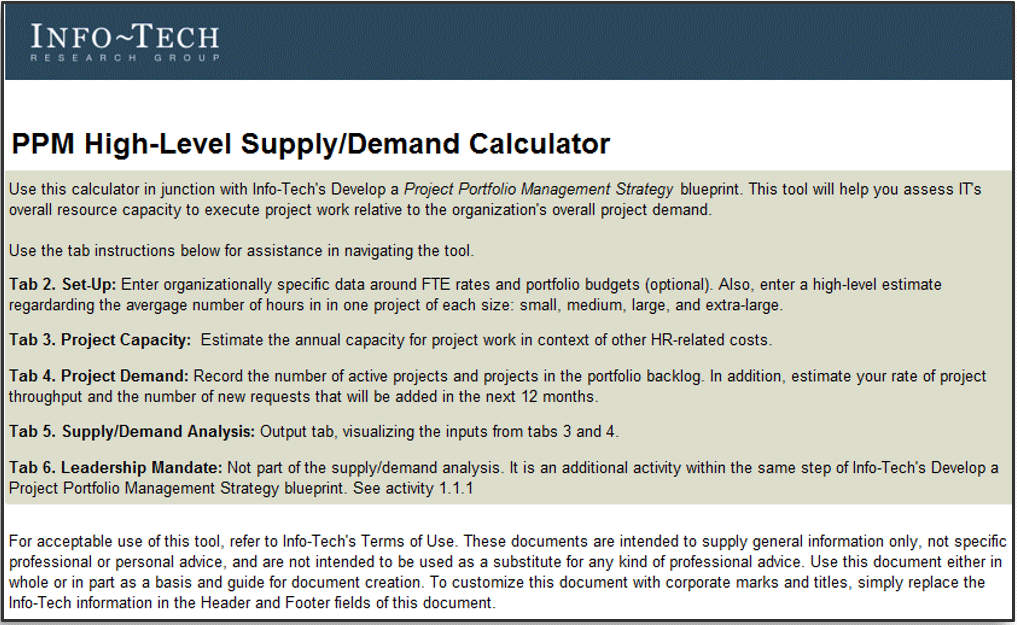
Info-Tech Insight
Where does the time go? The portfolio manager (or equivalent) should function as the accounting department for time, showing what’s available in IT’s human resources budget for projects and providing ongoing visibility into how that budget of time is being spent.
Establish the total resource capacity of your portfolio
INPUT: Staff resource types, Average work week, Estimated allocations
OUTPUT: Breakdown of annual portfolio HR spend, Capacity pie chart
Materials: PPM High-Level Supply/Demand Calculator, tab 3
Participants: Portfolio manager (or equivalent), Resource and/or project managers
Use tab 3 of the calculator to determine your actual HR portfolio budget for projects, relative to the organization’s non-project demands.
- Tab 3 analyzes your resource supply asks you to consider how your staff spend their time weekly across four categories: out of office time, administrative time (e.g. meetings, training, checking email), keep-the-lights-on time (i.e. support and maintenance), and project time.
- The screenshot below walks you through columns B to E of tab 3, which help calculate your potential capacity. This activity will continue on the next slide, where we will determine your realized capacity for project work from this potential capacity.
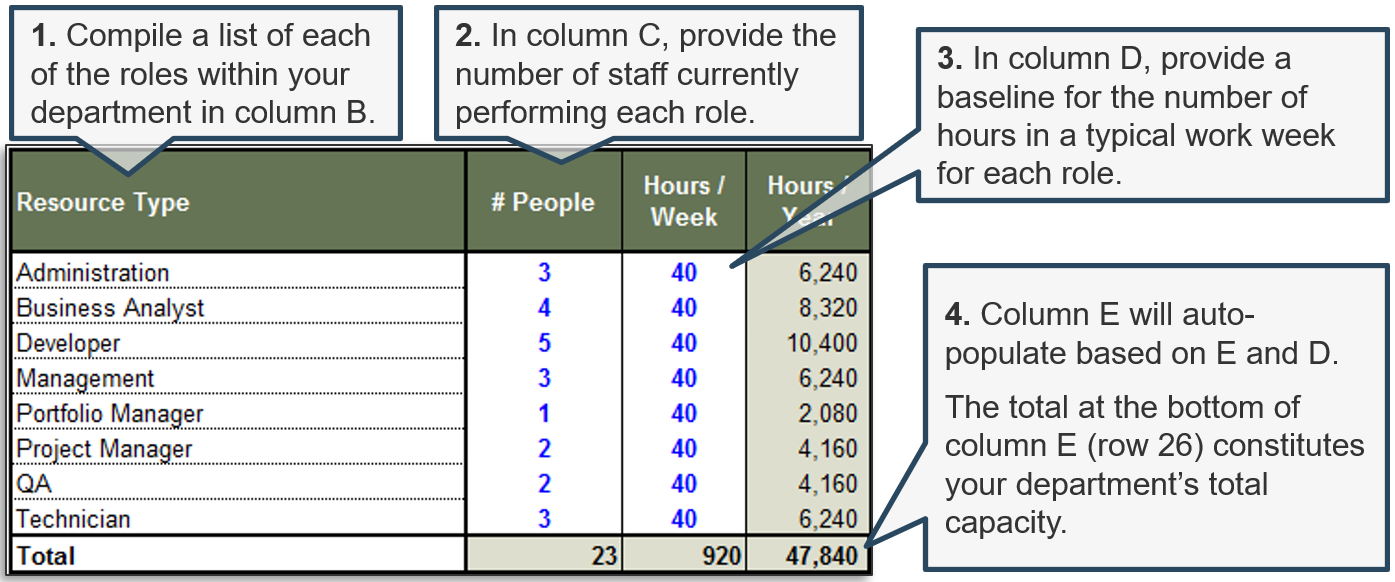
Determine the project/non-project ratio for each role
The previous slide walked you through columns B to E of tab 3. This slide walks you through columns F to J, which ask you to consider how your potential capacity is spent.
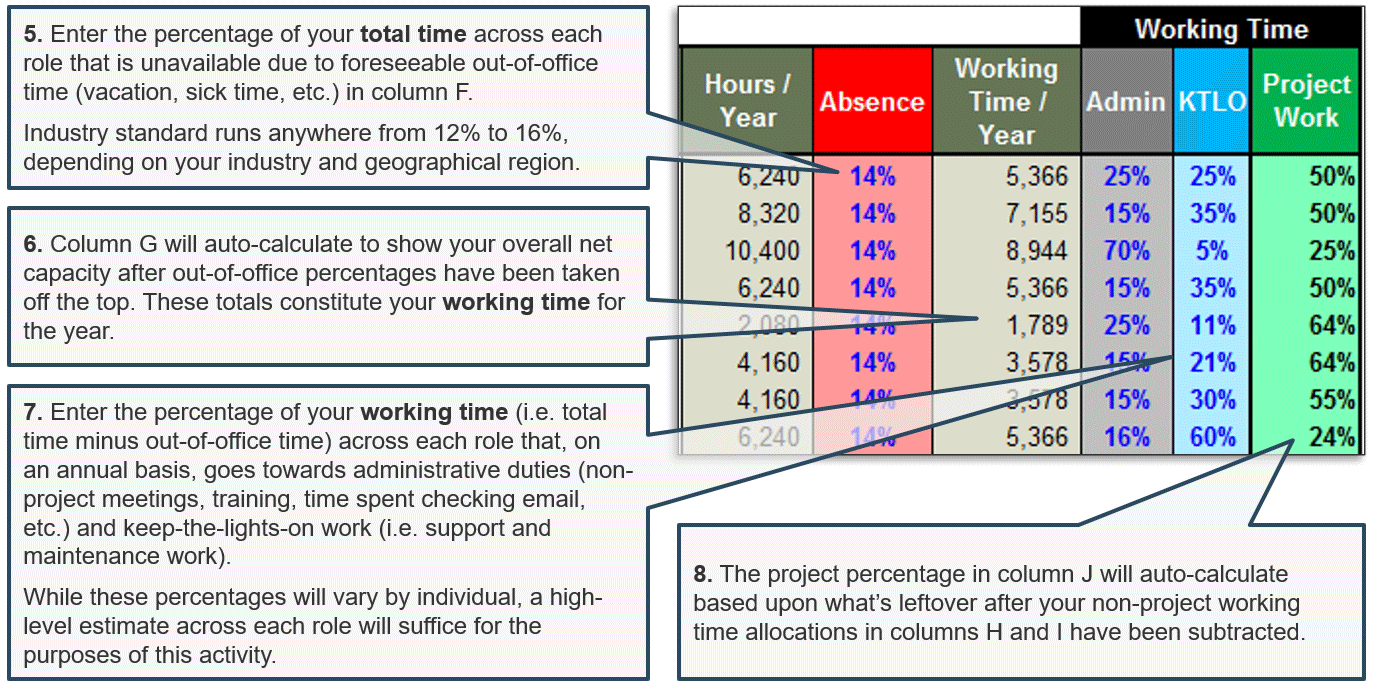
Review your annual portfolio capacity for projects
The previous slides walked you through the inputs for tab “3. Project Capacity.” This slide walks you through the outputs of the tab.
Based upon the inputs from columns B to J, the rest of tab 3 analyzes how IT available time is spent across the time categories, highlighting how much of IT’s capacity is actually available for projects after admin work, support and maintenance work, and absences have been taken into account.

Customize Info-Tech’s PPM Strategic Plan Template. Update slide 10, “Current Project Capacity,” of your PPM Strategic Plan Template to include the outputs from tab 3 of the Calculator.
Create an inventory of active and backlog projects to help gauge overall project demand
INPUT: Number of active and backlog projects across different sizes
OUTPUT: Total project demand in estimated hours of work effort
Materials: PPM High-Level Supply/Demand Calculator, tab 4
Participants: Portfolio manager (or equivalent), Project managers
Where tab 3 of the Calculator gave you visibility into your overall resource supply for projects, tab 4 will help you establish insight into the demand side.
- Before starting on tab 4, be sure to enter the required project size data on the set-up tab.
- Using a list of current active projects, categorize the items on the list by size: small, medium, large, and extra large. Enter the number of projects in each category of project in column C of tab 4.
- Using a list of on-hold projects, or projects that have been approved but not started, categorize the list by size and enter the number of projects in each category in column D.
- In column E, estimate the number of new requests and projects across each size that you anticipate being added to the portfolio/backlog in the next 12 months. Use historical data from the past 12 to 24 months to inform your estimates.
- In column F, estimate the number of projects that you anticipate being completed in each size category in the next 12 months. Take the current state of active projects into account as you make your estimates, as well as throughput data from the previous 12 to 24 months.

Make supply and demand part of the conversation as you get buy-in for your top-down strategy
Tab 5 of the Calculator is an output tab, visualizing the alignment (or lack thereof) of project demand and resource supply.
Once tabs 3 and 4 are complete, use tab 5 to analyze the supply/demand data to help build your case for a top-down PPM strategy and get buy-in for it.
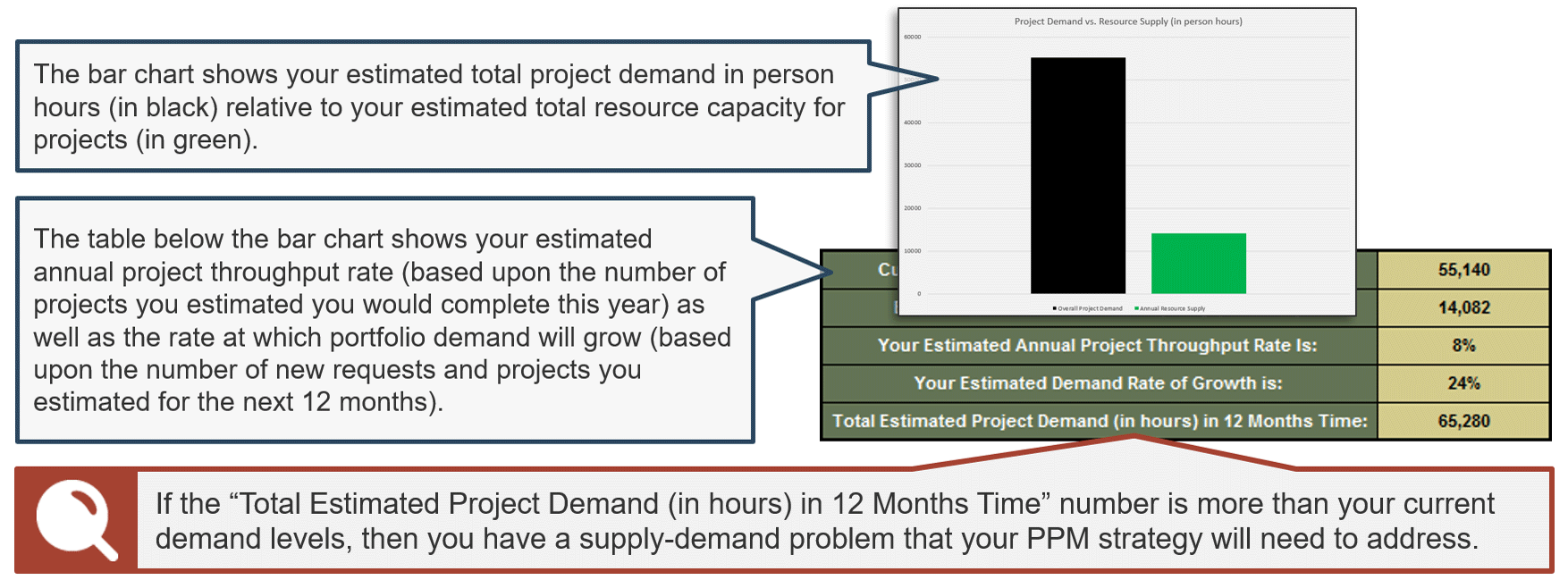
Customize Info-Tech’s PPM Strategic Plan Template. Update slides 11 and 12, “Current Project Demand,” of your PPM Strategic Plan Template to include the outputs from tabs 4 and 5 of the Calculator.
Recommended: Complete Info-Tech’s PPM Current State Scorecard to measure your resource utilization
This step is highly recommended but not required. Call 1-888-670-8889 to inquire about or request the PPM Diagnostics.
Info-Tech’s PPM Current State Scorecard diagnostic provides a comprehensive view of your portfolio management strengths and weaknesses, including project portfolio management, project management, customer management, and resource utilization.

Customize Info-Tech’s PPM Strategic Plan Template. Update slides 14 and 15, “Current State Resource Utilization” of your PPM Strategic Plan Template to include the resource utilization outputs from your PPM Current State Scorecard.
Finalize section one of the PPM Strategic Plan Template and prepare to communicate your strategy
INPUT: The previous activities from this step
OUTPUT: An presentation communication your PPM strategy
Materials: PPM Strategic Plan Template, section 1
Participants: Portfolio manager (or equivalent)
By now, you should be ready to complete section one of the PPM Strategic Plan Template.
The purpose of this section of the Template is to capture the outputs of this step and use them to communicate the value of a top-down PPM strategy and to get buy-in for this strategy from senior management before you move forward to develop your PPM processes in the subsequent phases of this blueprint.
- Within section one, update any of the text that is (in grey) to reflect the specifics of your organization – i.e. the name of your organization and department – and the specific outcomes of step 1.2 activities. In addition, replace the placeholders for a company logo with the logo of your company.
- Replace the tool screenshots with the outputs from your version of the PPM High-Level Supply/Demand Calculator.
- Proofread all of the text to ensure the content accurately reflects your outcomes. Edit the content as needed to more accurately reflect your outcomes.
- Determine the audience for the presentation of your PPM strategy and make a logistical arrangement. Include PPM strategy sponsors, senior management from within IT and the business, and other important stakeholders.
Get executive buy-in for your top-down PPM strategy
Executive layer buy-in is a critical prerequisite for the success of a top-down PPM strategy. Ensure your executives are on board before preceding.
You’re now ready to communicate your PPM strategy to your leadership team and other stakeholders.
It is essential that you get preliminary buy-in for this strategy from the executive layer before you move forward to develop your PPM processes in the subsequent phases of this blueprint. Lack of executive engagement is one of the top barriers to PPM strategy success.
- If you have gone through the preceding activities in this step, section one of your PPM Strategic Plan Template should now be ready to present.
- As explained in 1.1.4, you should present this section to an audience of PPM strategy sponsors, C-suite executives, and other members of the senior management team.
- Allow at least 60 minutes for the presentation – around 20 minutes to deliver the slide presentation and 40 minutes for discussion.
- If you get sufficient buy-in by the end of the presentation, proceed to the next step of this blueprint. If buy-in is lacking, now might not be the right time for a top-down PPM strategy. Think about adopting a bottom-up approach until leadership is more engaged in the portfolio.
"Gaining executive sponsorship early is key…It is important for the executives in your organization to understand that the PPM initiatives and the PMO organization are there to support (but never hinder) executive decision making." (KeyedIn Projects)
Info-Tech Best Practice
Engage(d) sponsorship. According to Prosci, the top factor in contributing to the success of a change initiative is active and visible executive sponsorship. Use this meeting to communicate to your sponsor(s) the importance of their involvement in championing the PPM strategy.
A PPM strategic plan elevates PMO’s status to a business strategic partner
CASE STUDY
Industry: Public Administration
Source: IAG / Info-Tech Interview
Challenge
The PMO operated in a way that is, in their self-assessment, reactive; project requests and capacity were not effectively managed. Perhaps due to this, the leadership team was not always visible, or regularly available, to PM leaders. This, in turn, complicated efforts to effectively manage their projects.
Solution
Establishing a simple prioritization methodology enabled the senior leadership to engage and effectively steer the project portfolio by strategic importance. The criteria and tool also gave the business units a clear understanding to promote the strategic value of each of their project requests.
Results
PM leaders now have the support and confidence of the senior leadership team to both proactively manage and deliver on strategic projects. This new prioritization model brought the PM Leader and senior leadership team in direct access with each other.
"By implementing this new project intake and prioritization framework, we drastically improved our ability to predict, meet, and manage project requests and unit workload. We adopted a client-focused and client-centric approach that enabled all project participants to see their role and value in successful project delivery. We created methodologies that were easy to follow from the client participation perspective, but also as PM leaders, provided us with the metrics, planning, and proactive tools to meet and anticipate client project demand. The response from our clients was extremely positive, encouraging, and appreciative."
Step 1.2: Translate PPM strategic expectations to process goals
PHASE 1 | PHASE 2 | PHASE 3 | |||
| 1.1 | 1.2 | 2.1 | 2.2 | 3.1 | 3.2 |
| Choose the right PPM strategy | Translate strategy into process goals | Define intake & resource mgmt. processes | Define reporting, closure, & benefits mgmt. processes | Select a right-sized PPM solution | Finalize your PPM strategic plan |
This step will walk you through the following activities:
- Determine process goals based upon your PPM strategy.
- Set metrics and preliminary targets for your PPM processes.
This step involves the following participants:
- CIO
- Steering Committee
- Business Unit Leaders
- PMO Director/Portfolio Manager
Outcomes of this step
- Stakeholder-prioritized PPM process goals
- Metrics and targets for high-priority process goals
Use the PPM strategy to set the direction for PPM processes that make up the infrastructure around projects
PPM strategy enables you to answer any and all of these questions in a way that is consistent, cohesive, and aligned with one another.
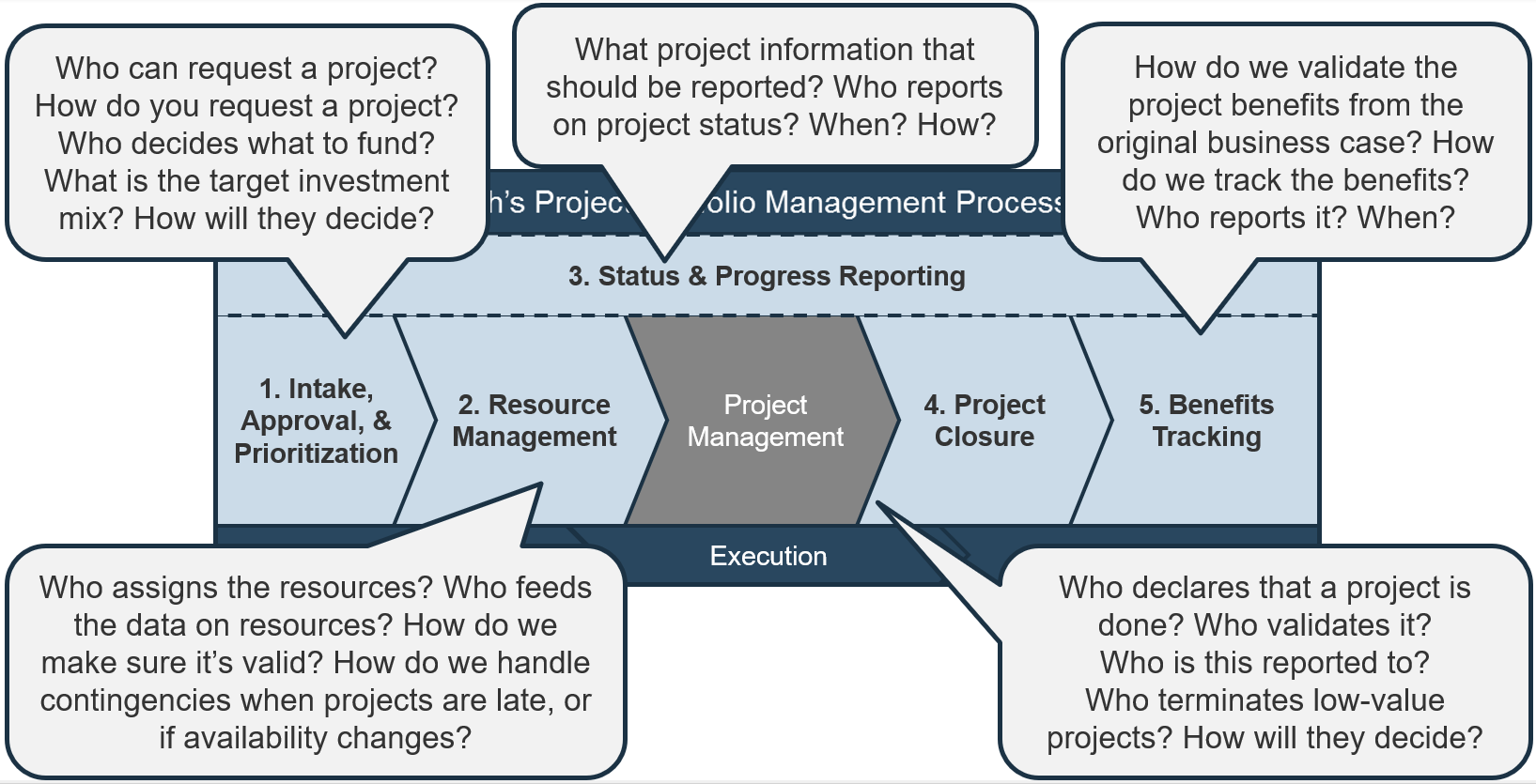
Set process goals to address PPM strategic expectations and steer the PPM strategic plan
INPUT: PPM strategy & expectations, Organizational strategy and culture
OUTPUT: Prioritized list of strategy-aligned PPM process goals
Materials: PPM Strategy-Process Translation Matrix
Participants: CIO, Steering Committee, Business Unit Leaders, PMO Director/ Portfolio Manager
This activity is designed for key departmental stakeholders to articulate how PPM processes should be developed or refined to meet the PPM strategic expectations.
Participation of the key departmental stakeholders in this exercise is critical, e.g. CIO, Steering Committee, business unit leaders.
| Strategic Expectations | x | Processes | = | Process goals aligned to strategy |
| Throughput | Project Intake, Approval, & Prioritization | |||
| Visibility | Resource Management | |||
| Responsiveness | Status & Progress Reporting | |||
| Resource Utilization | Project Closure | |||
| Benefits | Benefits Realization |
Download Info-Tech’s PPM Strategy-Process Goals Translation Matrix Template.
Use Info-Tech’s Translation Matrix to systematically articulate strategy-aligned PPM process goals
Formula: To answer “[question]” in a way that we can [strategic expectation], it will be important to [process goal].
Example 1:
To answer the question “who can request a project, and how?” in a way that we can maximize the throughput of the best projects, it will be important to standardize the project request process.
Example 2:
To answer the question “how will they decide what to fund?” in a way that we can maximize the throughput of the best projects, it will be important to reach a consensus on project prioritization criteria.
Example 3:
To answer the question “how will we track the projected benefits?” in a way that we can maximize the throughput of the best projects, it will be important to double-check the validity of benefits before projects are approved.
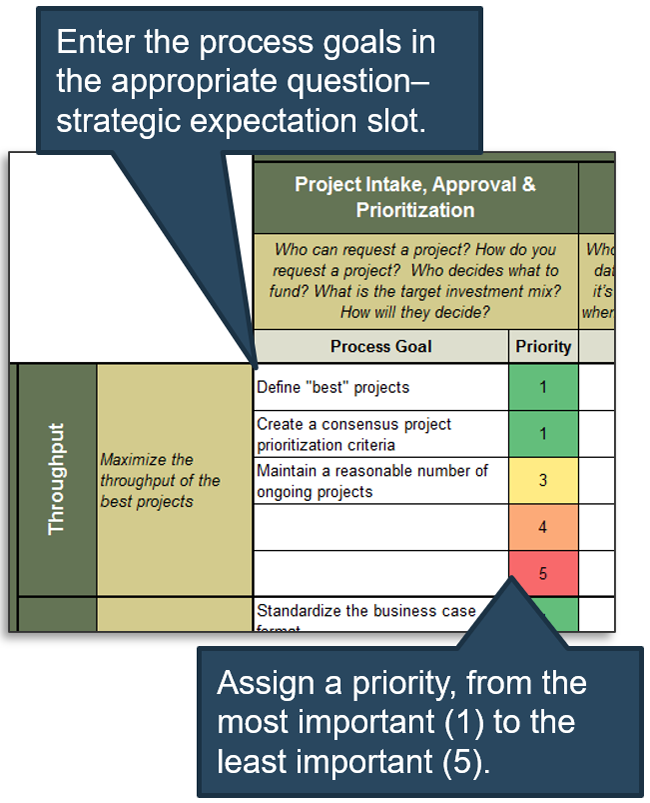
Set metrics and preliminary targets for your high-priority PPM process goals
![]() 1.2.2 – 1-2 hours
1.2.2 – 1-2 hours
INPUT: Prioritized list of strategy-aligned PPM process goals, Organizational strategy and culture
OUTPUT: Metrics and targets for high-priority PPM process goals
Materials: PPM Strategy-Process Translation Matrix
Participants: CIO, Steering Committee, Business Unit Leaders, PMO Director/ Portfolio Manager
Your highest-priority process goals and their corresponding strategy expectations are displayed in tab 3 of the PPM Strategy-Process Translation Matrix template (example below).
Through a group discussion, document what will be measured to decide the achievement of each process goal, as well as your current estimate and the long-term target. If necessary, adjust the approximate target duration.
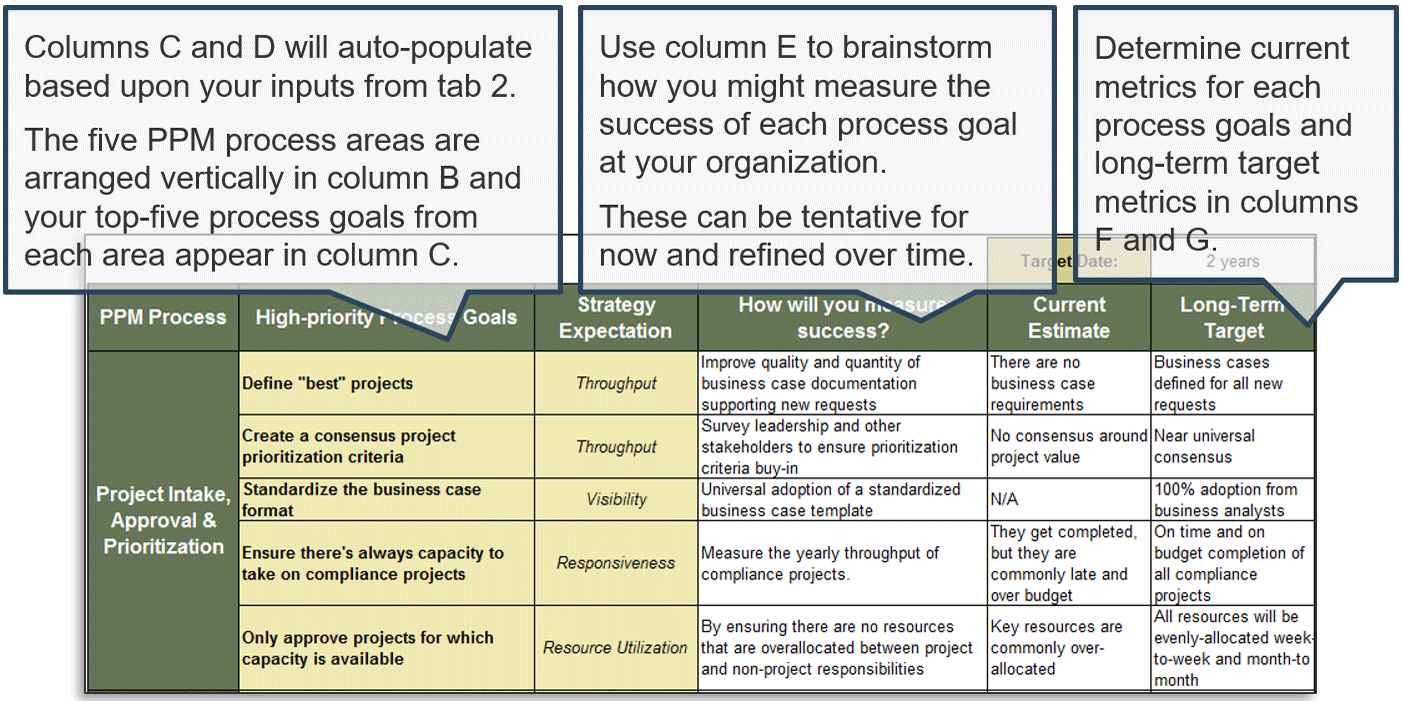
Project-client-centered approach to PPM process design improves client satisfaction and team confidence
CASE STUDY
Industry: Public Administration
Source: IAG / Info-Tech Interview
Challenge
Reactive instead of proactive
"We had no effective means of tracking project intake requests vs. capacity. We struggled using ad hoc processes and methods which worked to meet immediate needs, but we quickly realized that they were ineffective in tracking critical project metrics, key performance indicators (KPIs), or performance measures...In short, we were being reactive, instead of proactive."
The result was a disorganized portfolio that led to low client satisfaction and team morale.
Solution
Examine processes “through the eyes of the client”
With the guiding principle of “through the eyes of the client,” PPM processes and tools were developed to formalize project intake, prioritization, and capacity planning. All touchpoints between client and PPM processes were identified, and practices for managing client expectations were put in place. A client satisfaction survey was formulated as part of the post-project assessment and review.
Results
Client-centered processes improved client satisfaction and team confidence
People, processes, and tools are now aligned to support client demand, manage client expectations, measure project KPIs, and perform post-project analysis. A standard for client satisfaction metrics was put in place. The overwhelmingly positive feedback has increased team confidence in their ability to deliver quality efforts.
If you want additional support, have our analysts guide you through this phase as part of an Info-Tech Workshop 
Book a workshop with our Info-Tech analysts:
 |
|
The following are sample activities that will be conducted by Info-Tech analysts with your team:
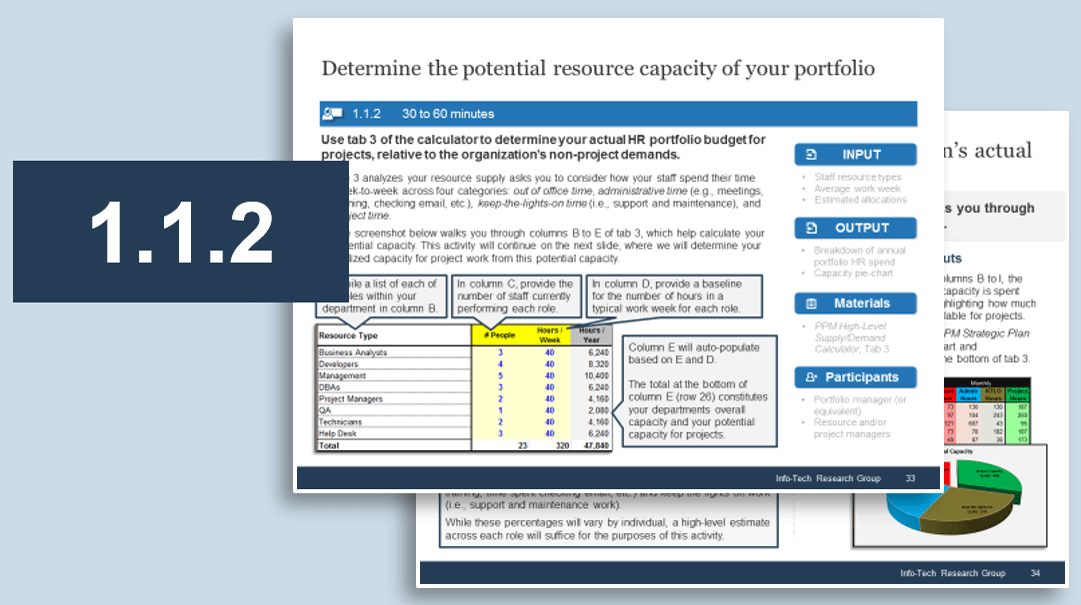 |
Determine your actual resource capacity for projects
Work with Info-Tech analysts to define your project vs. non-project ratio to help define how much of your overall resource capacity is actual available for projects. |
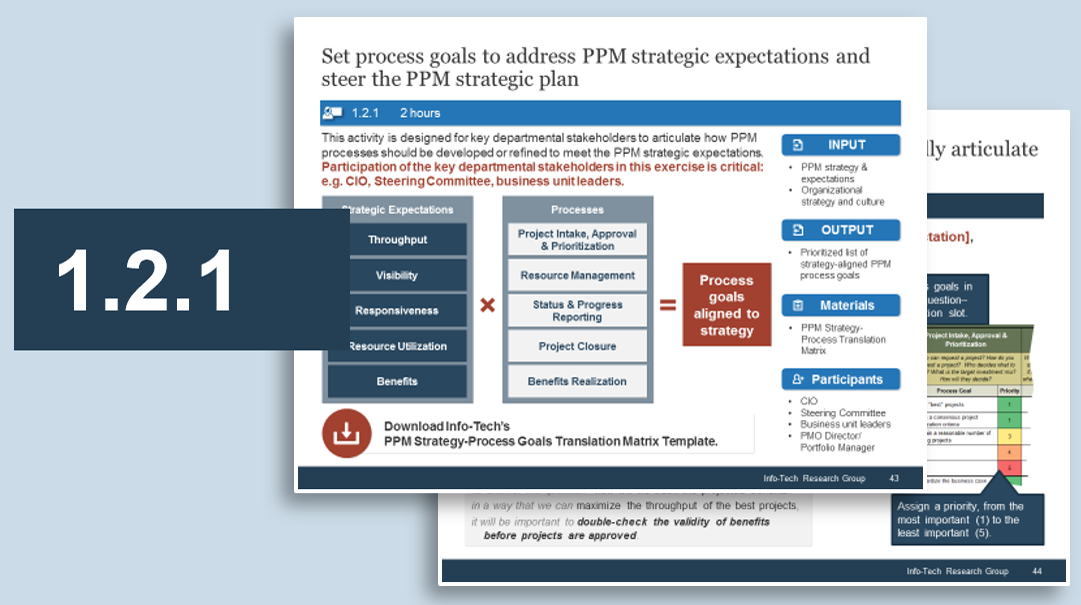 |
Set realistic PPM process goals
Leverage Info-Tech facilitators to help walk you through our PPM framework and define achievable process goals that are rooted in your current PPM maturity levels and organizational culture. |
Develop a Project Portfolio Management Strategy
PHASE 2
Align PPM Processes to Your Strategic Goals
Phase 2 outline
![]() Call 1-888-670-8889 or email GuidedImplementations@InfoTech.com for more information.
Call 1-888-670-8889 or email GuidedImplementations@InfoTech.com for more information.
Complete these steps on your own, or call us to complete a guided implementation. A guided implementation is a series of 2-3 advisory calls that help you execute each phase of a project. They are included in most advisory memberships.
Guided Implementation 2: Align PPM processes to your strategic goals
Proposed Time to Completion: 2-4 weeks
| Step 2.1: Develop intake & resource mgmt. processes | Step 2.2: Define reporting, closure, & benefits processes |
Work with an analyst to:
|
Work with an analyst to:
|
Then complete these activities…
|
Then complete these activities…
|
With these tools & templates:
|
With these tools & templates:
|
Phase 2 Results & Insights
|
|
Read first: Overview of the methodology for articulating new strategy-aligned PPM processes
In the previous step of the blueprint, key department stakeholders established the PPM process goals, metrics, and targets in a way that aligns with the overall PPM strategy. In this phase, we draft a high-level description of the five PPM processes that reflect those goals using the following methodology:
Methodology at a glance
- Articulate the current state of the process.
- Examine the process against the strategy-aligned goals.
- Create short- and long-term action items to refine the current process and meet the strategy-aligned targets.
- Develop a high-level target-state description of the PPM process.
- Estimate costs-in-use of the target-state process.
Out-of-scope topics
- Draft a detailed target-state description of the PPM process. Avoid falling into the “analysis paralysis” trap and keep the discussion focused on the overall PPM strategy.
- PPM tools to support the process. This discussion will take place in the next phase of the blueprint.
INPUT |
–› | PROCESS |
–› | OUTPUT |
|
|
|
Download Info-Tech’s PPM Strategy Development Tool
Build a sound business case for implementing the new PPM strategy with realistic costs and benefits of managing your project portfolio.
Time spent on managing the project portfolio is an investment. Like any other business endeavors, the benefits must outweigh the costs to be worth doing.
As you draft a high-level description of the PPM processes in this phase of the blueprint, use Info-Tech’s PPM Strategy Development Tool to track the estimate the cost-in-use of the process. In the next phase, this information will be inform a cost-benefit analysis, which will be used to support your plan to implement the PPM strategy.
Download Info-Tech’s PPM Strategy Development Tool.
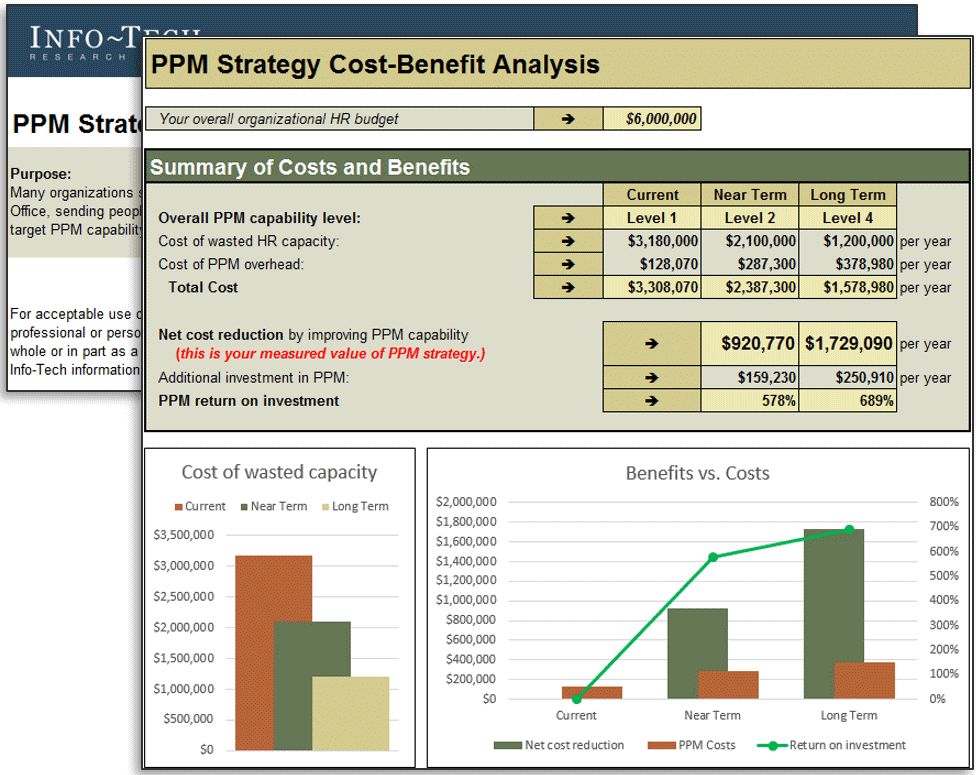
Step 2.1: Develop and refine project intake, prioritization, and resource management processes
PHASE 1 | PHASE 2 | PHASE 3 | |||
| 1.1 | 1.2 | 2.1 | 2.2 | 3.1 | 3.2 |
| Choose the right PPM strategy | Translate strategy into process goals | Define intake & resource mgmt. processes | Define reporting, closure, & benefits mgmt. processes | Select a right-sized PPM solution | Finalize your PPM strategic plan |
This step will walk you through the following activities:
- Determine your process maturity.
- Benchmark current processes against strategy-aligned goals.
- Set near- and long-term action items.
- Draft a high-level description of your target state.
- Document your new processes.
This step involves the following participants:
- PMO Director/Portfolio Manager
- Project Managers
- Resource Managers
- Business Analysts
Outcomes of this step
- A definition of current and target state maturity levels for intake, prioritization, and resource management
- Near-term and long-term process goals for intake, prioritization, and resource management
- A high-level wireframe for your intake, prioritization, and resource management process steps
Project intake, prioritization, and approval: Get projects with the highest value done first
Give your organization the voice to say “no” (or “not yet”) to new projects.
Questions
- Who can request a project?
- How do you request a project?
- Who decides what to fund?
- What is the target investment mix?
- How will they decide?
Benefits
- Maximize value of time spent on project work by aligning projects with priorities and stakeholder needs.
- Finish the projects you start by improving alignment of intake and prioritization with resource capacity.
- Improve stakeholder satisfaction by managing expectations with consistent, streamlined processes.
Challenges
- Stakeholders who benefit from political or ad hoc prioritization processes will resist or circumvent formal intake processes.
- Many organizations lack sufficient awareness of resource capacity necessary to align intake with availability.
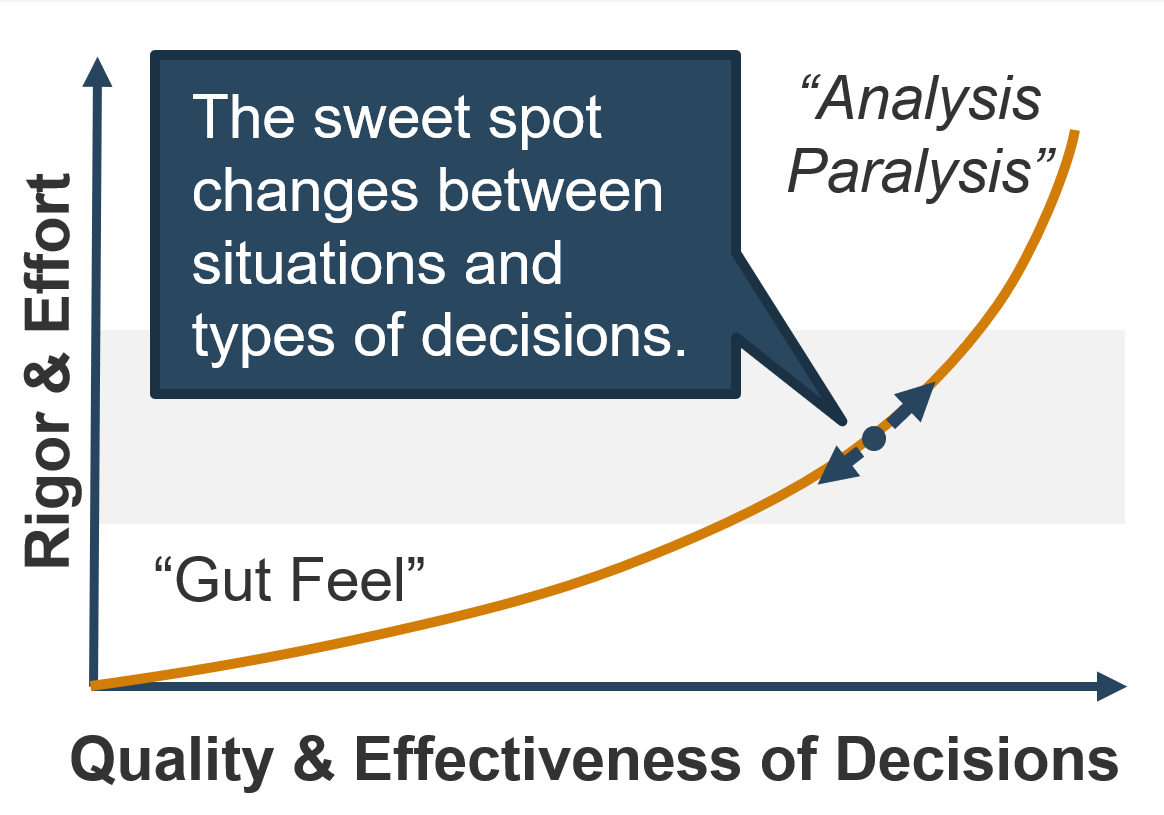
Info-Tech Insight
This process aims to control the project demand. A balance between rigor and flexibility is critical in order to avoid the “analysis paralysis” as much as the “gut feel” approach.
Funnel project requests into a triage system for project intake
Info-Tech recommends following a four-step process for managing project intake.
- Requestor fills out form and submits the request into the funnel.
- Requests are triaged into the proper queue.
- Divert non-project request.
- Quickly assess value and urgency.
- Assign specialist to follow up on request.
- Inform the requestor.
- Business analyst starts to gather preliminary requirements.
- Follow up with sponsors to validate and define scope.
- Estimate size and determine project management rigor required.
- Start to develop an initial business case.
- Requestor is given realistic expectations for approval process.
Info-Tech Best Practice
An excess number of intake channels is the tell-tale sign of a project portfolio in distress. The PMO needs to exercise and enforce discipline on stakeholders. PMO should demand proper documentation and diligence from stakeholders before proceeding with requests.
Maintain reliable resourcing data with a recurrent project intake, prioritization, and approval practice
Info-Tech recommends following a five-step process for managing project intake, prioritization, and approval.
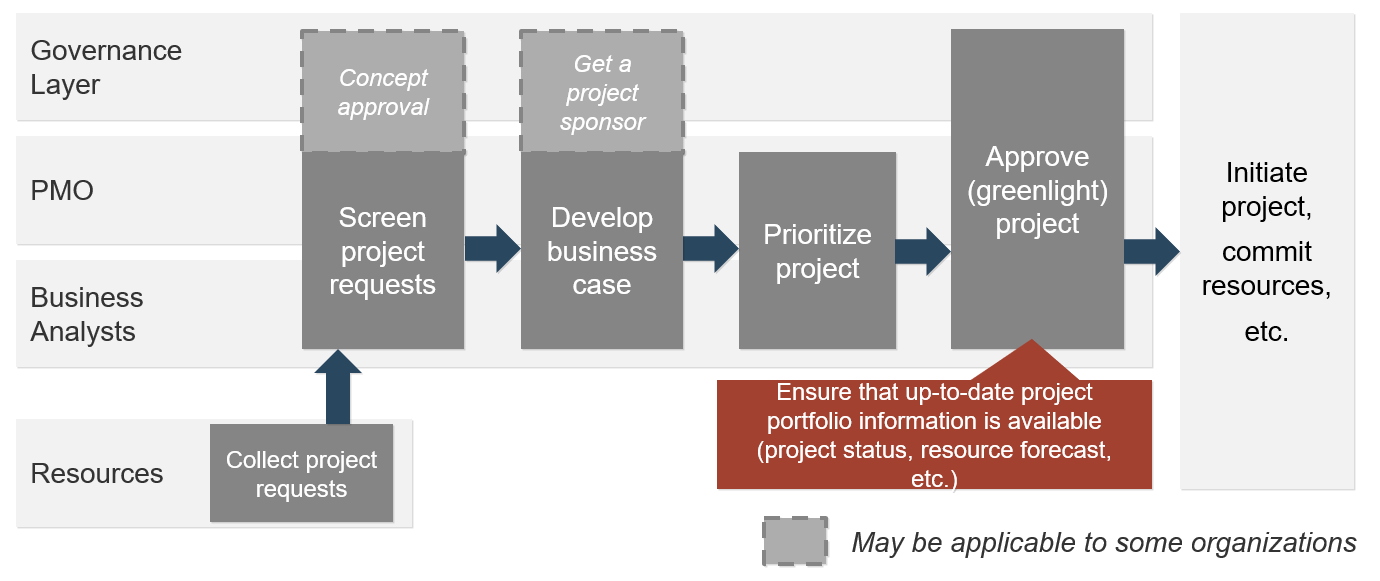
Info-Tech Insight
“Approval” can be a dangerous word in project and portfolio management. Use it carefully. Clarify precisely what is being “approved” at each step in the process, what is required to pass each gate, and how long the process will take.
Determine your project intake, prioritization, and approval process maturity
INPUT: Organizational strategy and culture
OUTPUT: Project intake, prioritization, and approval capability level
Materials: PPM Strategy Development Tool
Participants: PMO Director/ Portfolio Manager, Project Managers, Resource Managers, Business Analysts
Kick-off the discussion about the project intake, prioritization, and approval process by reading the capability level descriptions below and discussing which level currently applies to you the most.
Capability Level Descriptions |
|
| Capability Level 5: Optimized | We have effective intake processes with right-sized administrative overhead. Work is continuously prioritized to keep up with emerging challenges and opportunities. |
| Capability Level 4: Aligned | We have very strong intake processes. Project approvals are based on business cases and aligned with future resource capacity. |
| Capability Level 3: Engaged | Processes are in place to track project requests and follow up on them. Priorities are periodically re-evaluated, based largely on the best judgment of one or several executives. |
| Capability Level 2: Defined | Some processes are in place, but there is no capacity to say no to new projects. There is a backlog, but little or no method for grooming it. |
| Capability Level 1: Unmanaged | Our organization has no formal intake processes in place. Most work is done reactively, with little ability to prioritize project work proactively. |
Benchmark the current project intake, prioritization, and approval process against strategy-aligned goals
![]() 2.1.1b – 1-2 hours
2.1.1b – 1-2 hours
INPUT: Documentation describing the current process (e.g. standard operating procedures), Process goals from activity 1.2.1
OUTPUT: Retrospective review of current process
Materials: 4x6” recipe cards, Whiteboard
Participants: PMO Director/ Portfolio Manager, Project Managers, Resource Managers, Business Analysts
Conduct a table-top planning exercise to map out the process currently in place.
- Use white 4”x6” recipe cards to write unique steps of a process. Use the intake, prioritization, and approval process from the previous slides as a guide.
- Use green cards to write artifacts or deliverables that result from a step.
- Use pink cards to write issues, problems, or risks.
- Discuss how the process could better achieve the strategy-aligned goals from activity 1.2.1. Keep a list of possible changes in the form of a start-stop-continue retrospective (example below) on a whiteboard.
| Start | Stop | Continue |
|
|
|
Set near- and long-term action items for the project intake, prioritization, and approval process
![]() 2.1.1c – 30 minutes - 1 hour
2.1.1c – 30 minutes - 1 hour
INPUT: Outcome of the retrospective review, Process goals and metrics from activity 1.2.1
OUTPUT: Action items for evolving the process to a target state
Materials: Whiteboard
Participants: PMO Director/ Portfolio Manager, Project Managers, Resource Managers, Business Analysts
Analyze each item in the start-stop-continue retrospective to compile a set of near-term and long-term action items.
| The near-term plan should include steps that are within the authority of the PMO and do not require approval or investment outside of that authority. | The long-term plan should include steps that may require a longer approval process, buy-in of external stakeholders, and the investment of time and money. | |
| Near-Term Action Items | Long-Term Action Items | |
For example:
|
For example:
|
Review and customize slide 23, “Project intake, prioritization, and approval: action items,” in Info-Tech’s PPM Strategic Plan Template.
Draft a high-level description of the intake, prioritization, and approval process at a target state
![]() 2.1.1d – 1-2 hours
2.1.1d – 1-2 hours
INPUT: Action items for evolving the process to a target state
OUTPUT: High-level description of the process at the target state
Materials: Whiteboard, PPM Strategy Development Tool
Participants: PMO Director/ Portfolio Manager, Project Managers, Resource Managers, Business Analysts
- Break down the process into several tasks at a high level. Avoid getting into too much detail by limiting the number of steps.
- Describe each task by answering the following questions. Document your response in the PPM Strategic Plan Template.
- Record the time cost of each process using the PPM Strategy Development Tool; see next slide for instructions.
| An example of high-level breakdown: project intake, prioritization, and approval | ||||||||
| Collect project requests | –› | Screen requests | –› | Develop business case | –› | Prioritize project | –› | Approve project |
Question |
Description |
| Input | What information do you need to perform the work? |
| Output | What artifacts/deliverables are produced as a result? |
| Frequency/Timing | How often, and when, will the work be performed? |
| Responsibility | Who will perform the work? |
| Accountability | Who will approve the work and assume the ownership of any decisions? |
Use the PPM Strategy Development Tool to track the time cost of the process
Record the time cost of each high-level process task from Activity 2.1.1d.
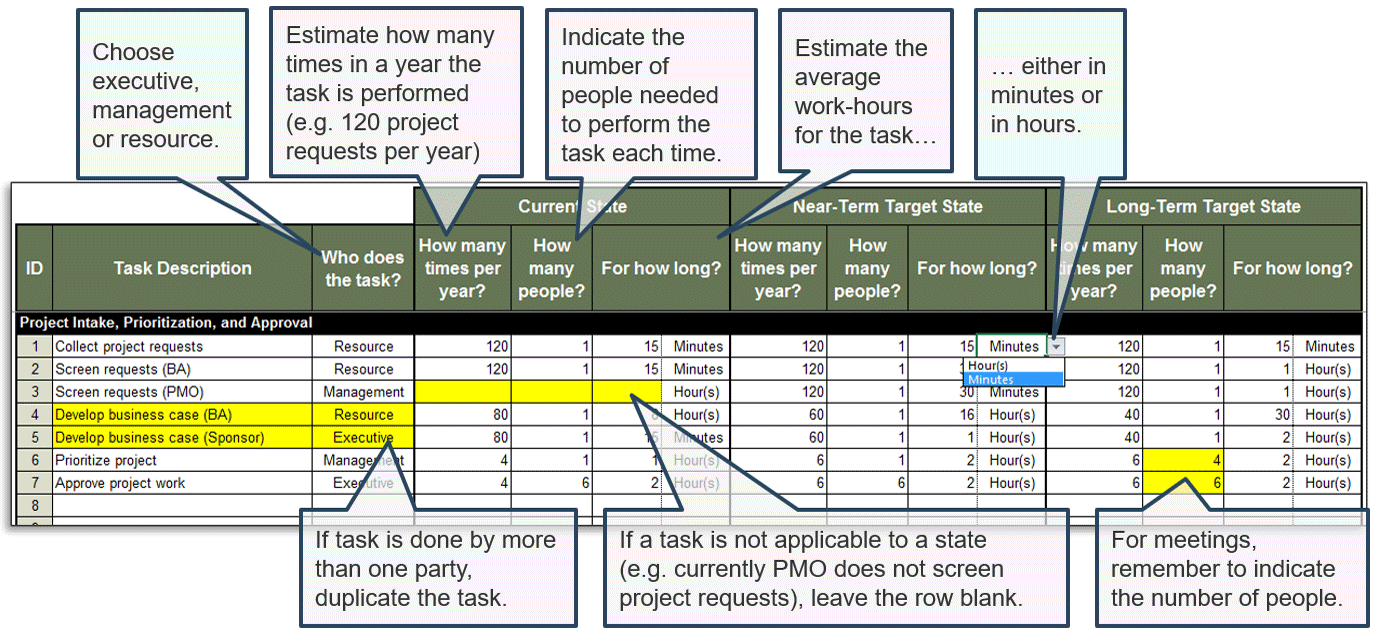
Document the high-level description for the new intake, prioritization, and approval process
INPUT: High-level description of the process at the target state
OUTPUT: Updated PPM strategic plan
Materials: Whiteboard, PPM Strategic Plan Template
Participants: PMO Director/ Portfolio Manager
Update your PPM strategic plan with the new high-level description for the new project intake, prioritization, and approval process. Depending on your current process capability level, you may wish to include additional information on your strategic document, for example:
- Updated prioritization scorecard.
- Roles and responsibility matrix, identifying consulted and informed parties.
Info-Tech has a dedicated blueprint to help you develop the high-level process description into a fully operationalized process. Upon completion of this PPM strategy blueprint, speak to an Info-Tech account manager or analyst to get started.
Read Info-Tech’s Optimize Project Intake, Prioritization, and Approval blueprint.
Review and customize slide 24, “Project intake, prioritization, and approval: target state,” in Info-Tech’s PPM Strategic Plan Template.
Clarity in project prioritization process leads to enterprise-wide buy-in
CASE STUDY
Industry: Public Administration
Source: IAG / Info-Tech Interview
Challenge
"Our challenge from the start was to better understand the strategic perspective and priorities of our client departments.
In addition, much of the work requested was not aligned to corporate goals and efforts, and seemed to be contradictory, redundant, and lacking strategic focus."
Complicating this challenge was the fact that work requests were being received via all means of communication, which made the monitoring and controlling of requests more difficult.
Solution
Client departments were consulted to improve the understanding of their strategic goals and priorities. Based on the consultation:
- A new, enterprise-wide project prioritization criteria was developed.
- Priority of project requests from all business areas are evaluated on a quarterly basis.
- A prioritized list of projects are made available to the senior leadership team.
Results
"By creating and implementing a tool for departments to prioritize strategic efforts, we helped them consider the important overall project criteria and measure them uniformly, across all anticipated projects. This set a standard of assessment, prioritization, and ranking, which helped departments clearly see which efforts were supportive and matched their strategic goals."
Resource management process ensures that projects get the resources they need
Reclaim project capacity: properly allocate project work and establish more stable project timelines.
Questions
- Who assigns the resources?
- Who feeds the data on resources?
- How do we make sure it’s valid?
- How do we handle contingencies when projects are late, or if availability changes?
Benefits
- Ensure that approved projects can be completed by aligning intake with real project capacity.
- Reduce over-allocation of resources by allocating based on their proportion of project vs. non-project work.
- Forecast future resource requirements by maintaining accurate resource capacity data.
Challenges
- Time tracking can be difficult when project workers balance project work with “keep the lights on” activities and other administrative work.
- Continuous partial attention, interruptions, and distractions are a part of today’s reality that makes it very difficult to maximize productivity.
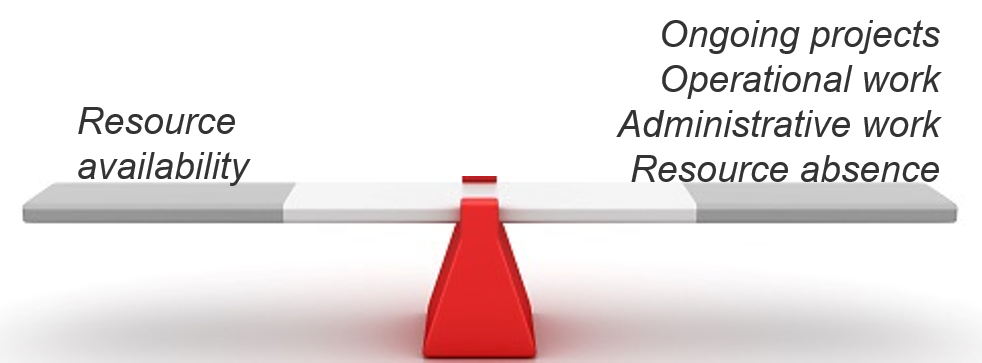
Maintain reliable resourcing data with a recurrent resource management practice
Info-Tech recommends following a five-step process for resource management.
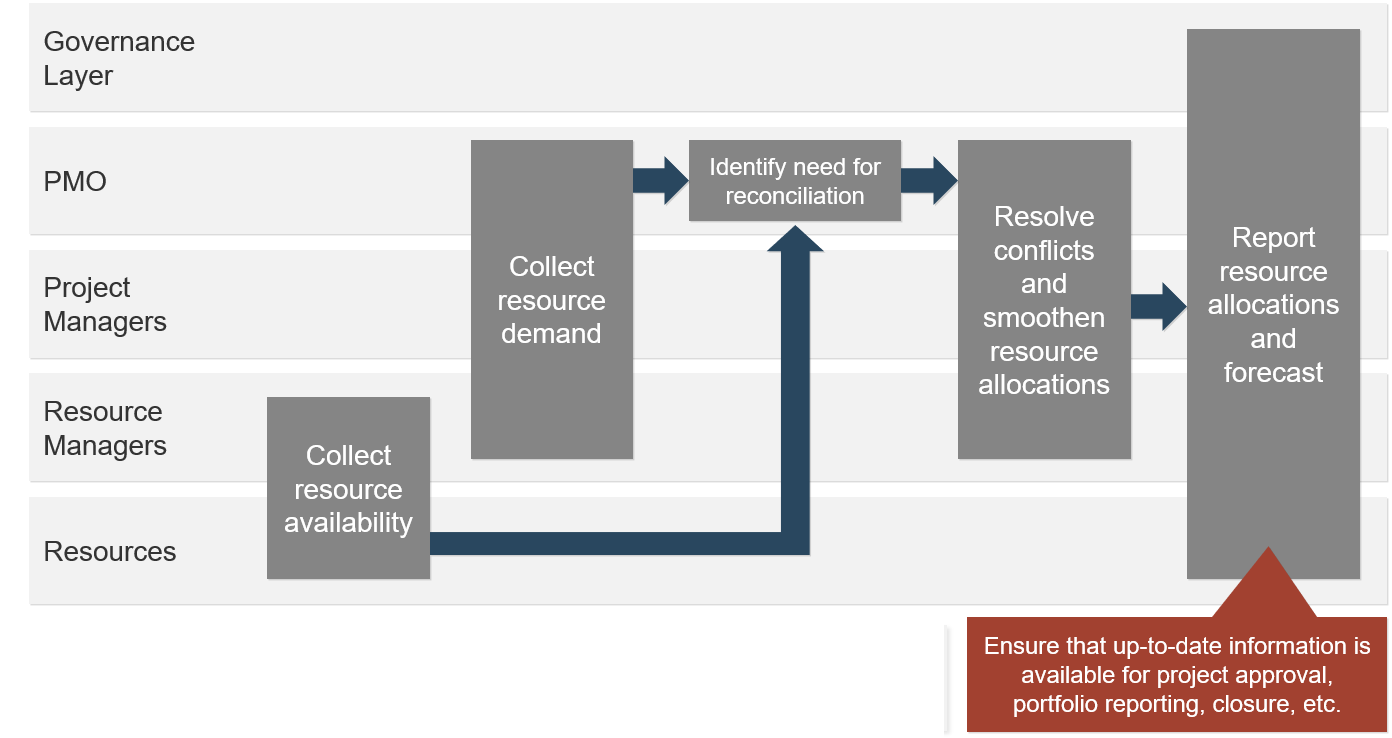
Info-Tech Insight
This process aims to control the resource supply to meet the demand – project and non-project alike. Coordinate this process with the intake, approval, and prioritization process.
Determine your resource management process capability level
![]() 2.1.2a – 10 minutes
2.1.2a – 10 minutes
INPUT: Organizational strategy and culture
OUTPUT: Resource management capability level
Materials: PPM Strategy Development Tool
Participants: PMO Director/ Portfolio Manager, Project Managers, Resource Managers, Business Analysts
Kick-off the discussion about the resource management process by reading the capability level descriptions below and discussing which level currently applies to you the most.
Capability Level Descriptions | |
| Capability Level 5: Optimized | Our organization has an accurate picture of project versus non-project work loads and allocates resources accordingly. We periodically reclaim lost capacity through organizational and behavioral change. |
| Capability Level 4: Aligned | We have an accurate picture of how much time is spent on project versus non-project work. We allocate resources to these projects accordingly. We are checking in on project progress bi-weekly. |
| Capability Level 3: Pixelated | We are allocating resources to projects and tracking progress monthly. We have a rough estimate of how much time is spent on project versus non-project work. |
| Capability Level 2: Opaque | We match resources teams to projects and check in annually, but we do not forecast future resource needs or track project versus non-project work. |
| Capability Level 1: Unmanaged | Our organization expects projects to be finished, but there is no process in place for allocating resources or tracking project progress. |
Benchmark the current resource management process against strategy-aligned goals
![]() 2.1.2b – 1-2 hours
2.1.2b – 1-2 hours
INPUT: Documentation describing the current process (e.g. standard operating procedures), Process goals from activity 1.2.1
OUTPUT: Retrospective review of current process
Materials: 4x6” recipe cards, Whiteboard
Participants: PMO Director/ Portfolio Manager, Project Managers, Resource Managers, Business Analysts
Conduct a table-top planning exercise to map out the process currently in place.
- Use white 4”x6” recipe cards to write unique steps of a process. Use the resource management process from the previous slides as a guide.
- Use green cards to write artifacts or deliverables that result from a step.
- Use pink cards to write issues, problems, or risks.
- Discuss how the process could better achieve the strategy-aligned goals from activity 1.2.1. Keep a list of possible changes in the form of a start-stop-continue retrospective (example below) on a whiteboard.
| Start | Stop | Continue |
|
|
|
Set near- and long-term action items for the resource management process
![]() 2.1.2c – 30 minutes - 1 hour
2.1.2c – 30 minutes - 1 hour
INPUT: Outcome of the retrospective review, Process goals and metrics from activity 1.2.1
OUTPUT: Action items for evolving the process to a target state
Materials: Whiteboard
Participants: PMO Director/ Portfolio Manager, Project Managers, Resource Managers, Business Analysts
Analyze each item in the start-stop-continue retrospective to compile a set of near-term and long-term action items.
| The near-term plan should include steps that are within the authority of the PMO and do not require approval or investment outside of that authority. | The long-term plan should include steps that may require a longer approval process, buy-in of external stakeholders, and the investment of time and money. | |
| Near-Term Action Items | Long-Term Action Items | |
For example:
|
For example:
|
Review and customize slide 26, “Resource management: action items,” in Info-Tech’s PPM Strategic Plan Template.
Draft a high-level description of the resource management process at a target state
![]() 2.1.2d – 1-2 hours
2.1.2d – 1-2 hours
INPUT: Action items for evolving the process to a target state
OUTPUT: High-level description of the process at the target state
Materials: Whiteboard, PPM Strategy Development Tool
Participants: PMO Director/ Portfolio Manager, Project Managers, Resource Managers, Business Analysts
- Break down the process into several tasks at a high level. Avoid getting into too much detail by limiting the number of steps.
- Describe each task by answering the following questions. Document your response in the PPM Strategic Plan Template.
- Record the time cost of each process using the PPM Strategy Development Tool.
| An example of high-level breakdown: resource management | ||||||||
| Collect resource availability | –› | Collect resource demand | –› | Identify need for reconciliation | –› | Resolve conflicts and over-allocation | –› | Update resource forecast |
Question |
Description |
| Input | What information do you need to perform the work? |
| Output | What artifacts/deliverables are produced as a result? |
| Frequency/Timing | How often, and when, will the work be performed? |
| Responsibility | Who will perform the work? |
| Accountability | Who will approve the work and assume the ownership of any decisions? |
Document the high-level description for the new resource management process
![]() 2.1.2e – 30 minutes - 1 hour
2.1.2e – 30 minutes - 1 hour
INPUT: High-level description of the process at the target state
OUTPUT: Updated PPM strategic plan
Materials: PPM Strategic Plan Template
Participants: PMO Director/ Portfolio Manager
Update your PPM strategic plan with the new high-level description for the new resource management process. Depending on your current process capability level, you may wish to include additional information on your strategic plan, for example:
- Resource management meeting agenda template
- Roles and responsibility matrix, identifying consulted and informed parties
Info-Tech has a dedicated blueprint to help you develop the high-level process description into a fully operationalized process. Upon completion of this PPM strategy blueprint, speak to an Info-Tech account manager or analyst to get started.
Read Info-Tech’s Develop a Resource Management for the New Reality blueprint.
Review and customize slide 27, “Resource management: target state,” in Info-Tech’s PPM Strategic Plan Template.
Step 2.2: Develop and refine portfolio reporting, project closure, and benefits realization processes
PHASE 1 | PHASE 2 | PHASE 3 | |||
| 1.1 | 1.2 | 2.1 | 2.2 | 3.1 | 3.2 |
| Choose the right PPM strategy | Translate strategy into process goals | Define intake & resource mgmt. processes | Define reporting, closure, & benefits mgmt. processes | Select a right-sized PPM solution | Finalize your PPM strategic plan |
This step will walk you through the following activities:
- Determine your process maturity.
- Benchmark current processes against strategy-aligned goals.
- Set near- and long-term action items.
- Draft a high-level description of your target state.
- Document your new processes.
This step involves the following participants:
- PMO Director/Portfolio Manager
- Project Managers
- Business Analysts
Outcomes of this step
- A definition of current and target state maturity levels for portfolio reporting, project closure, and benefits realization
- Near-term and long-term process goals for portfolio reporting, project closure, and benefits realization
- A high-level wireframe for your portfolio reporting, project closure, and benefits realization process steps
Portfolio reporting process makes trustworthy data accessible for informing decisions
Giving stakeholders the ability to make informed decisions is the most important function of managing the project portfolio.
Questions
- What project information should be reported?
- Who reports on project status?
- When and how do we report on the status of the project portfolio?
Benefits
- Reporting is the linchpin of any successful PPM strategy.
- Timely and accurate status reports enable decision makers to address issues risks and issues before they create bigger problems.
- Executive visibility can be achieved with or without a commercial tool using spreadsheets, a content management system such as SharePoint, or a combination of tools you already have.
Challenges
- Trying to increase detailed visibility too fast leads to difficulty gathering and maintaining data. As a result, reporting is rarely accurate and people quickly lose trust in the portfolio.
- If you are planning to adopt a commercial tool, Info-Tech strongly recommends validating your organization’s ability to maintain a consistent reporting process using simple tools before investing in a more sophisticated system.
Info-Tech Insight
If you can only do one thing, establish frequently current reporting on project status. Reporting doesn’t have to be detailed or precise, as long as it’s accurate.
Maintain reliable portfolio status data with a recurrent status and progress reporting practice
Info-Tech recommends following a four-step process for portfolio status and progress reporting.
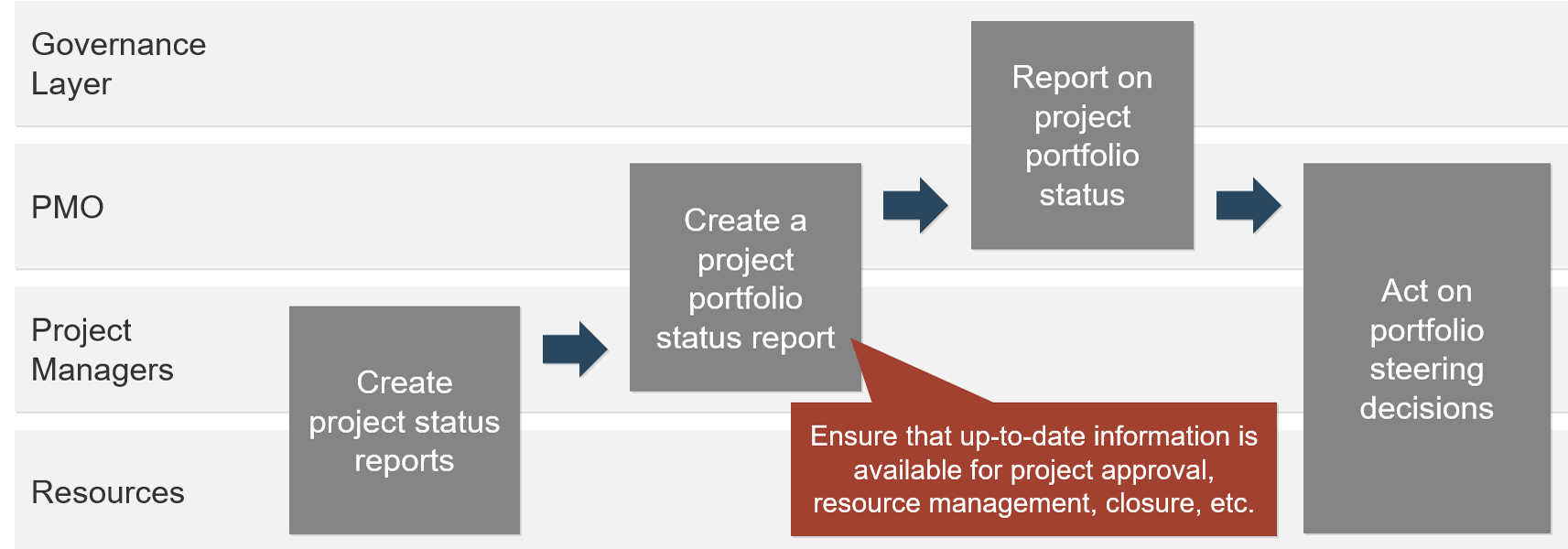
Start by establishing a regular reporting cadence with lightweight project status KPIs:
| Red | Issue or risk that requires intervention | For projects that are red or yellow, high-level status reports should be elaborated on with additional comments on budget, estimated hours/days until completion, etc. |
| Yellow | Issue or risk that stakeholders should be aware of | |
| Green | No significant risks or issues |
Determine your resource management process capability level
![]() 2.2.1a – 10 minutes
2.2.1a – 10 minutes
INPUT: Organizational strategy and culture
OUTPUT: Portfolio reporting capability level
Materials: PPM Strategy Development Tool
Participants: PMO Director/ Portfolio Manager, Project Managers
Kick-off the discussion about the portfolio reporting process by reading the capability level descriptions below and discussing which level currently applies to you the most.
Capability Level Descriptions | |
| Capability Level 5: Optimized | With the right tools, we can ensure that all projects are planned and maintained at a detailed task level with high-quality estimates, and that actual task progress is updated at least weekly. |
| Capability Level 4: Aligned | We have the skills, knowledge, and resources needed to prepare a detailed cost-benefit analysis for all proposed projects. We track the progress throughout project execution. |
| Capability Level 3: Intervention | With the right tools, we can ensure that project issues and risks are identified and addressed on a regular basis (e.g. at least monthly) for all projects. |
| Capability Level 2: Oversight | With the right tools, we can ensure that project status updates are revised on a regular basis (e.g. at least monthly) for all ongoing projects. |
| Capability Level 1: Reactive | Project managers escalate issues directly with their direct supervisor or project sponsor because there is no formal PPM practice. |
Benchmark the current portfolio reporting process against strategy-aligned goals
INPUT: Documentation describing the current process (e.g. standard operating procedures), Process goals from activity 1.2.1
OUTPUT: Retrospective review of current process
Materials: 4x6” recipe cards, Whiteboard
Participants: PMO Director/ Portfolio Manager, Project Managers
Conduct a table-top planning exercise to map out the process currently in place.
- Use white 4”x6” recipe cards to write unique steps of a process. Use the portfolio reporting process from the previous slides as a guide.
- Use green cards to write artifacts or deliverables that result from a step.
- Use pink cards to write issues, problems, or risks.
- Discuss how the process could better achieve the strategy-aligned goals from activity 1.2.1. Keep a list of possible changes in the form of a start-stop-continue retrospective (example below) on a whiteboard.
| Start | Stop | Continue |
|
|
|
Set near- and long-term action items for the portfolio reporting process
![]() 2.2.1c – 30 minutes - 1 hour
2.2.1c – 30 minutes - 1 hour
INPUT: Outcome of the retrospective review, Process goals and metrics from activity 1.2.1
OUTPUT: Action items for evolving the process to a target state
Materials: Whiteboard
Participants: PMO Director/ Portfolio Manager, Project Managers
Analyze each item in the start-stop-continue retrospective to compile a set of near-term and long-term action items.
| The near-term plan should include steps that are within the authority of the PMO and do not require approval or investment outside of that authority. | The long-term plan should include steps that may require a longer approval process, buy-in of external stakeholders, and the investment of time and money. | |
| Near-Term Action Items | Long-Term Action Items | |
For example:
|
For example:
|
Review and customize slide 29, “Portfolio reporting: action items,” in Info-Tech’s PPM Strategic Plan Template.
Draft a high-level description of the portfolio reporting process at a target state
![]() 2.2.1d – 1-2 hours
2.2.1d – 1-2 hours
INPUT: Action items for evolving the process to a target state
OUTPUT: High-level description of the process at the target state
Materials: Whiteboard, PPM Strategy Development Tool
Participants: PMO Director/ Portfolio Manager, Project Managers
- Break down the process into several tasks at a high level. Avoid getting into too much detail by limiting the number of steps.
- Describe each task by answering the following questions. Document your response in the PPM Strategic Plan Template.
- Record the time cost of each process using the PPM Strategy Development Tool.
| An example of high-level breakdown: portfolio reporting | ||||||
| Create project status reports | –› | Create a project portfolio status report | –› | Report on project portfolio status | –› | Act on portfolio steering decisions |
Question | Description |
| Input | What information do you need to perform the work? |
| Output | What artifacts/deliverables are produced as a result? |
| Frequency/Timing | How often, and when, will the work be performed? |
| Responsibility | Who will perform the work? |
| Accountability | Who will approve the work and assume the ownership of any decisions? |
Document the high-level description for the new portfolio reporting process
![]() 2.2.1e – 30 minutes - 1 hour
2.2.1e – 30 minutes - 1 hour
INPUT: High-level description of the process at the target state
OUTPUT: Updated PPM strategic plan
Materials: PPM Strategic Plan Template
Participants: PMO Director/ Portfolio Manager
Update your PPM strategic plan with the new high-level description for the new portfolio reporting process. Depending on your current process capability level, you may wish to include additional information on your strategic plan, for example:
- Updated project status report template with new KPIs.
- Documentation of requirements for improved PPM dashboards and reports.
Info-Tech has a dedicated blueprint to help you develop the high-level process description into a fully operationalized process. Upon completion of this PPM strategy blueprint, speak to an Info-Tech account manager or analyst to get started.
Read Info-Tech’s Enhance PPM Dashboards and Reports blueprint.
Review and customize slide 30, “Portfolio reporting: target state,” in Info-Tech’s PPM Strategic Plan Template.
Streamlined status reporting improves portfolio visibility for executives, enabling data-driven steering of the portfolio
CASE STUDY
Industry: Public Administration
Source: IAG / Info-Tech Interview
Challenge
The client had no effective real-time reporting in place to summarize their work efforts. In addition, the client struggled with managing existing resources against the ability to deliver on the requested project workload.
Existing project reporting processes were manually intensive and lacked mature reporting capabilities.
Solution
Through a short and effective engagement, IAG conducted surveys and facilitated interviews to identify the information needed by each stakeholder. From this analysis and industry best practices, IAG developed scorecards, dashboards, and project summary reports tailored to the needs of each stakeholder group. This integrated reporting tool was then made available on a central portal for PPM stakeholders.
Results
Stakeholders can access project scorecard and dashboard reports that are available at any given time.
Resource reporting enabled the PMO to better balance client demand with available project capacity and forecast any upcoming deficiencies in resourcing that affect project delivery.
Project closure at the portfolio level controls throughput and responsiveness of the portfolio
Take control over projects that linger on, projects that don’t provide value, and projects that do not align with changing organizational priority.
Questions
- Who declares that a project is done?
- Who validates it?
- Who is this reported to?
- Who terminates low-value projects?
- How will they decide that a project is too low value to continue?
Benefits
- Minimize post-implementation problems by ensuring clean handoffs, with clear responsibilities for ongoing support and maintenance.
- Drive continuous improvement by capturing and applying lessons learned.
- Increase the project portfolio’s responsiveness to change by responding to emerging opportunities and challenges.
Challenges
- Completion criteria and “definition of done” need to be well defined and done so at project initiation.
- Scope changes need to be managed and documented throughout the project.
- Portfolio responsiveness requires deep cultural changes that will be met with confusion and resistance from some stakeholders.
Info-Tech Insight
Although “change in organizational priority” is the most frequently cited cause of project failure (PMI Pulse of Profession, 2017), closing projects that don’t align with organizational priority ought to be a key PPM goal. Therefore, don’t think of it as project failure; instead, think of it as PPM success.
Maintain the health of the project portfolio with a repeatable project closure process
Info-Tech recommends following a four-step process for project closure.
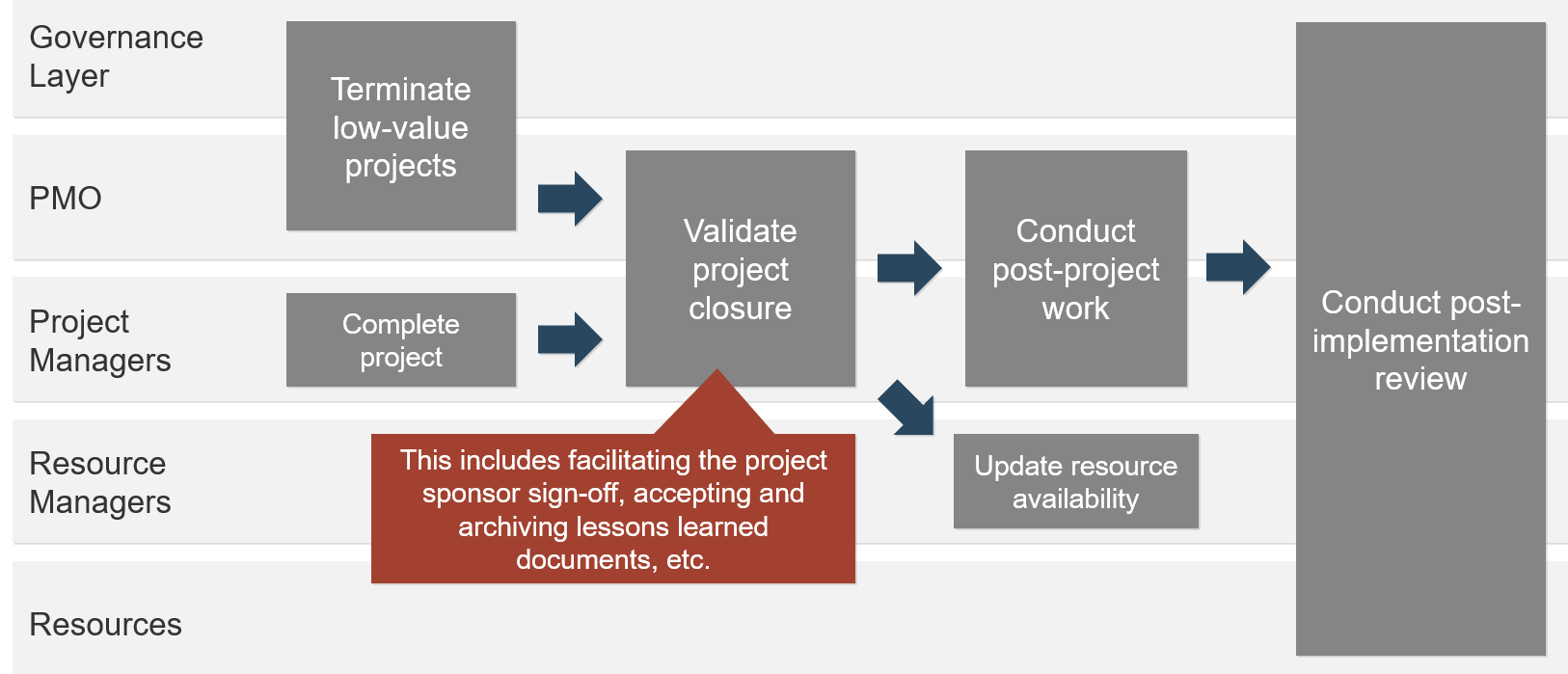
Info-Tech Best Practice
Post-implementation review checks which benefits (including those set out in the business case) have been achieved and identifies opportunities for further improvement. Without it, it can be difficult to demonstrate that investment in a project was worthwhile.
Determine your project closure process capability level
![]() 2.2.2a – 10 minutes
2.2.2a – 10 minutes
INPUT: Organizational strategy and culture
OUTPUT: Project closure capability level
Materials: PPM Strategy Development Tool
Participants: PMO Director/ Portfolio Manager, Project Managers, Business Analysts
Kick-off the discussion about the project closure process by reading the capability level descriptions below and discussing which level currently applies to you the most.
Capability Level Descriptions | |
| Capability Level 5: Optimized | Project closure is centrally managed and supports post-project benefits tracking. |
| Capability Level 4: Aligned | Project closure is centrally managed at the portfolio level to ensure completion/acceptance criteria are satisfied. |
| Capability Level 3: Engaged | Project closure is confirmed at the portfolio level, but with minimal enforcement of satisfaction of completion/acceptance criteria. |
| Capability Level 2: Encouraged | Project managers often follow handoff and closure procedures, but project closure is not confirmed or governed at the portfolio level. |
| Capability Level 1: Unmanaged | Project closure is not governed at either the project or portfolio level. |
Benchmark the current project closure process against strategy-aligned goals
![]() 2.2.2b – 1-2 hours
2.2.2b – 1-2 hours
INPUT: Documentation describing the current process (e.g. standard operating procedures), Process goals from activity 1.2.1
OUTPUT: Retrospective review of current process
Materials: 4x6” recipe cards, Whiteboard
Participants: PMO Director/ Portfolio Manager, Project Managers, Business Analysts
Conduct a table-top planning exercise to map out the process currently in place.
- Use white 4”x6” recipe cards to write unique steps of a process. Use the project closure process from the previous slides as a guide.
- Use green cards to write artifacts or deliverables that result from a step.
- Use pink cards to write issues, problems, or risks.
- Discuss how the process could better achieve the strategy-aligned goals from activity 1.2.1. Keep a list of possible changes in the form of a start-stop-continue retrospective (example below) on a whiteboard.
| Start | Stop | Continue |
|
|
|
Set near- and long-term action items for the project closure process
![]() 2.2.2c – 30 minutes - 1 hour
2.2.2c – 30 minutes - 1 hour
INPUT: Outcome of the retrospective review, Process goals and metrics from activity 1.2.1
OUTPUT: Action items for evolving the process to a target state
Materials: Whiteboard
Participants: PMO Director/ Portfolio Manager, Project Managers, Resource Managers, Business Analysts
Analyze each item in the start-stop-continue retrospective to compile a set of near-term and long-term action items.
| The near-term plan should include steps that are within the authority of the PMO and do not require approval or investment outside of that authority. | The long-term plan should include steps that may require a longer approval process, buy-in of external stakeholders, and the investment of time and money. | |
| Near-Term Action Items | Long-Term Action Items | |
For example:
|
For example:
|
Review and customize slide 32, “Project closure: action items,” in Info-Tech’s PPM Strategic Plan Template.
Draft a high-level description of the project closure process at a target state
![]() 2.2.2d – 1-2 hours
2.2.2d – 1-2 hours
INPUT: Action items for evolving the process to a target state
OUTPUT: High-level description of the process at the target state
Materials: Whiteboard, PPM Strategy Development Tool
Participants: PMO Director/ Portfolio Manager, Project Managers, Resource Managers, Business Analysts
- Break down the process into several tasks at a high level. Avoid getting into too much detail by limiting the number of steps.
- Describe each task by answering the following questions. Document your response in the PPM Strategic Plan Template.
- Record the time cost of each process using the PPM Strategy Development Tool.
| An example of high-level breakdown: project closure | ||||||
| Complete or terminate projects | –› | Validate project closure | –› | Conduct post-project work | –› | Conduct post-implementation review |
Question |
Description |
| Input | What information do you need to perform the work? |
| Output | What artifacts/deliverables are produced as a result? |
| Frequency/Timing | How often, and when, will the work be performed? |
| Responsibility | Who will perform the work? |
| Accountability | Who will approve the work and assume the ownership of any decisions? |
Document the high-level description for the new project closure process
![]() 2.2.2e – 30 minutes - 1 hour
2.2.2e – 30 minutes - 1 hour
INPUT: High-level description of the process at the target state
OUTPUT: Updated PPM strategic plan
Materials: PPM Strategic Plan Template
Participants: PMO Director/ Portfolio Manager
Update your PPM strategic plan with the new high-level description for the new project closure process. Depending on your current process capability level, you may wish to include additional information on your strategic plan, for example:
- Updated project closure checklist.
- Project value review meeting process document.
- Post-implementation review process document.
Info-Tech has several research notes that elaborate on aspects of project closure. Upon completion of this PPM strategy blueprint, speak to an Info-Tech account manager or analyst to get started.
Read Info-Tech’s research notes on project closure:
- The Importance of Conducting a Post Implementation Review
- Five Key Steps to Mastering Project Closure
- ‘Governance’ Will Kill Your Projects
Review and customize slide 33, “Project closure: target state,” in Info-Tech’s PPM Strategic Plan Template.
Validate the time and effort spent on projects with a benefits realization process
Maximizing benefits from projects is the primary goal of PPM. Tracking and reporting on benefits post-project closes the loop on benefits.
Questions
- How do validate the project benefits from the original business case?
- How do we track the benefits?
- Who reports it? When?
Benefits
- Maximize benefits realization by identifying and addressing unforeseen issues or limitations to success.
- Improve project approval and prioritization by improving validity of the business case definition process.
Challenges
- Project sponsors need to be willing to invest time – months and years post-project completion – to validate benefits realization.
- Portfolio management needs to proactively work with sponsors to facilitate benefits tracking.
- Business cases need to be well developed and documented to reflect real anticipated benefits.
Too many projects fail to achieve the originally proposed benefits, and too few organizations are able to identify and address the root causes of those shortfalls.
Info-Tech Insight
In reality, benefits realization process extends across the entire project life cycle: during intake, during the execution of the project, and after project completion. Be mindful of this extended scope when you discuss benefits realization in the following activity.
Keep project benefits front and center with a repeatable benefits realization process
Info-Tech recommends following a four-step process for benefits realization.
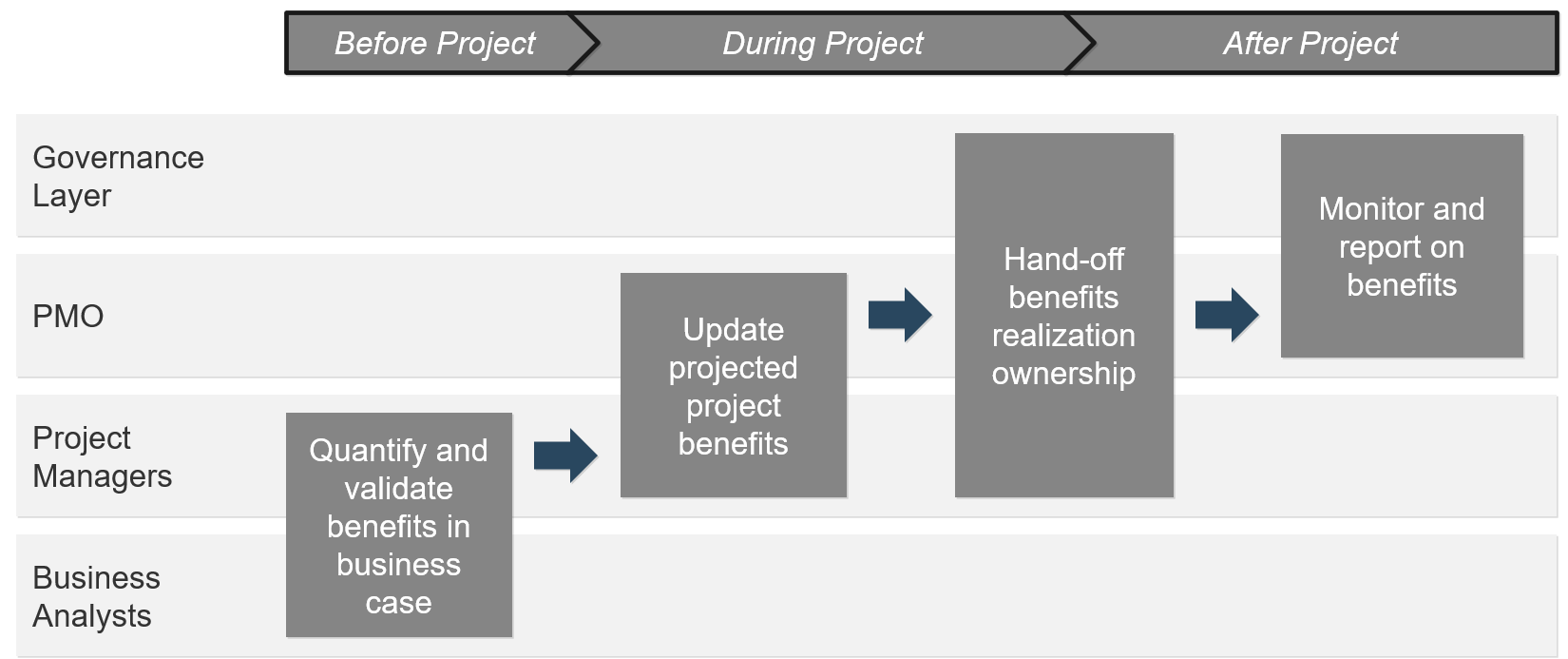
Info-Tech Insight
At the heart of benefits realization is accountability: who is held accountable for projects that don’t realize the benefits and how? Without the buy-in from the entire executive layer team, addressing this issue is very difficult.
Determine your benefits realization process capability level
![]() 2.2.3a – 10 minutes
2.2.3a – 10 minutes
INPUT: Organizational strategy and culture
OUTPUT: benefits realization capability level
Materials: PPM Strategy Development Tool
Participants: PMO Director/ Portfolio Manager, Project Managers, Resource Managers, Business Analysts
Kick-off the discussion about the benefits realization process by reading the capability level descriptions below and discussing which level currently applies to you the most.
Capability Level Descriptions | |
| Capability Level 5: Optimized | Project sponsors and key stakeholders are accountable for stated project benefits before, during and after the project. There is a process to maximize the realization of project benefits. |
| Capability Level 4: Aligned | Project benefits are forecasted and taken into account for approval, updated when changes are made to the project, and monitored/reported after projects are completed. |
| Capability Level 3: Engaged | Project benefits are forecasted and taken into account for approval, and there is a loosely defined process to report on benefits realization. |
| Capability Level 2: Defined | Project benefits are forecasted and taken into account for approval, but there is no process to monitor whether the said benefits are realized. |
| Capability Level 1: Unmanaged | Projects are approved and initiated without discussing benefits. |
Benchmark the current benefits realization process against strategy-aligned goals
![]() 2.2.3b – 1-2 hours
2.2.3b – 1-2 hours
INPUT: Documentation describing the current process (e.g. standard operating procedures), Process goals from activity 1.2.1
OUTPUT: Retrospective review of current process
Materials: 4x6” recipe cards, Whiteboard
Participants: PMO Director/ Portfolio Manager, Project Managers, Resource Managers, Business Analysts
Conduct a table-top planning exercise to map out the process currently in place.
- Use white 4”x6” recipe cards to write unique steps of a process. Use the benefits realization process from the previous slides as a guide.
- Use green cards to write artifacts or deliverables that result from a step.
- Use pink cards to write issues, problems, or risks.
- Discuss how the process could better achieve the strategy-aligned goals from activity 1.2.1. Keep a list of possible changes in the form of a start-stop-continue retrospective (example below) on a whiteboard.
| Start | Stop | Continue |
|
|
Set near- and long-term action items for the benefits realization process
![]() 2.2.3c – 30 minutes - 1 hour
2.2.3c – 30 minutes - 1 hour
INPUT: Outcome of the retrospective review, Process goals and metrics from activity 1.2.1
OUTPUT: Action items for evolving the process to a target state
Materials: Whiteboard
Participants: PMO Director/ Portfolio Manager, Project Managers, Resource Managers, Business Analysts
Analyze each item in the start-stop-continue retrospective to compile a set of near-term and long-term action items.
| The near-term plan should include steps that are within the authority of the PMO and do not require approval or investment outside of that authority. | The long-term plan should include steps that may require a longer approval process, buy-in of external stakeholders, and the investment of time and money. | |
| Near-Term Action Items | Long-Term Action Items | |
For example:
|
For example:
|
Review and customize slide 35, “Benefits realization: action items,” in Info-Tech’s PPM Strategic Plan Template.
Draft a high-level description of the benefits realization process at a target state
![]() 2.2.3d – 1-2 hours
2.2.3d – 1-2 hours
INPUT: Action items for evolving the process to a target state
OUTPUT: High-level description of the process at the target state
Materials: Whiteboard, PPM Strategy Development Tool
Participants: PMO Director/ Portfolio Manager, Project Managers, Resource Managers, Business Analysts
- Break down the process into several tasks at a high level. Avoid getting into too much detail by limiting the number of steps.
- Describe each task by answering the following questions. Document your response in the PPM Strategic Plan Template.
- Record the time cost of each process using the PPM Strategy Development Tool.
| An example of high-level breakdown: benefits realization | ||||||
| Validate benefits in business case | –› | Update project benefits during execution | –› | Hand-off benefits ownership | –› | Monitor and report on benefits |
Question | Description |
| Input | What information do you need to perform the work? |
| Output | What artifacts/deliverables are produced as a result? |
| Frequency/Timing | How often, and when, will the work be performed? |
| Responsibility | Who will perform the work? |
| Accountability | Who will approve the work and assume the ownership of any decisions? |
Document the high-level description for the new benefits realization process
![]() 2.2.3e – 30 minutes - 1 hour
2.2.3e – 30 minutes - 1 hour
INPUT: High-level description of the process at the target state
OUTPUT: Updated PPM strategic plan
Materials: PPM Strategic Plan Template
Participants: PMO Director/ Portfolio Manager
Update your PPM strategic plan with the new high-level description for the new benefits realization process. Depending on your current process capability level, you may wish to include additional information on your strategic plan, for example:
- Updated business plan templates.
- Communication plan for project sponsors.
Info-Tech has a dedicated blueprint to help you develop the high-level process description into a fully operationalized process. Upon completion of this PPM strategy blueprint, speak to an Info-Tech account manager or analyst to get started.
Read Info-Tech’s Establish the Benefits Realization Process blueprint.
Review and customize slide 36, “Benefits realization: target state,” in Info-Tech’s PPM Strategic Plan Template.
If you want additional support, have our analysts guide you through this phase as part of an Info-Tech Workshop 
Book a workshop with our Info-Tech analysts:
 |
|
The following are sample activities that will be conducted by Info-Tech analysts with your team:
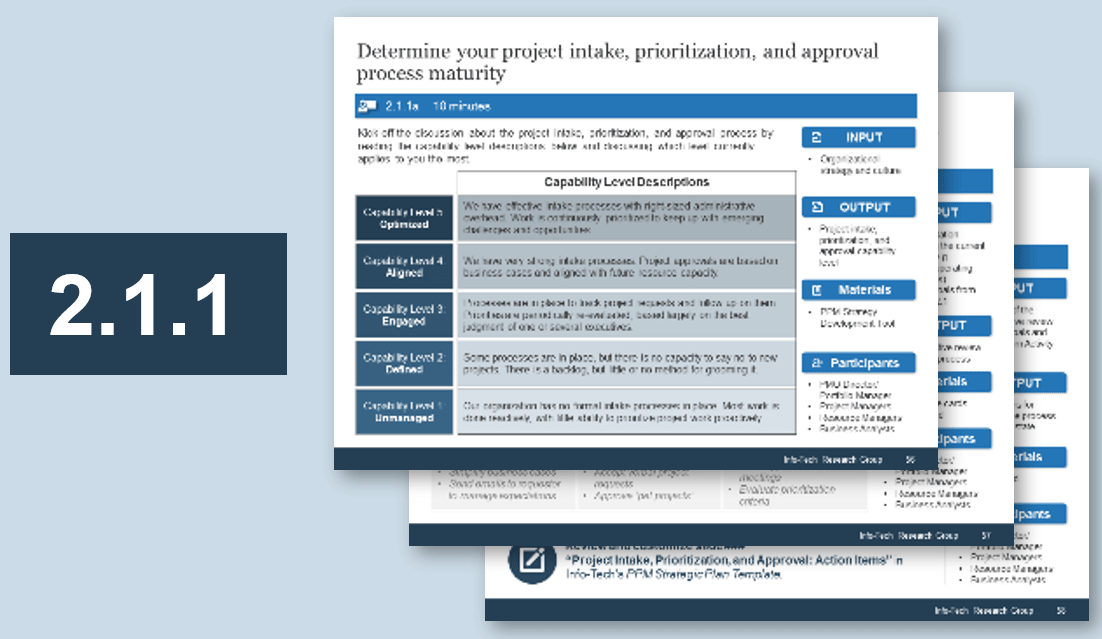 |
Align your project intake, prioritization, and approval process to the PPM strategy
Examine the process at the current state and develop an action plan to improve it, with a high-level description of the process at a target state and its overhead costs. The outcome of this activity feeds into the overall PPM strategic plan. |
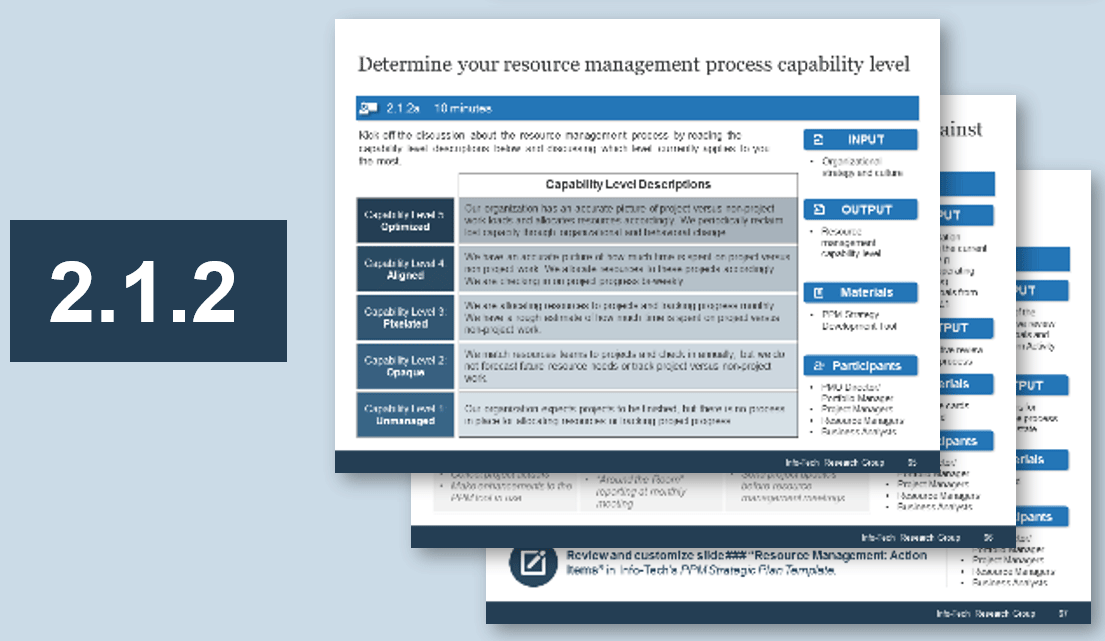 |
Align your resource management process to the PPM strategy
Examine the process at the current state and develop an action plan to improve it, with a high-level description of the process at a target state and its overhead costs. The outcome of this activity feeds into the overall PPM strategic plan. |
If you want additional support, have our analysts guide you through this phase as part of an Info-Tech Workshop 
Book a workshop with our Info-Tech analysts:
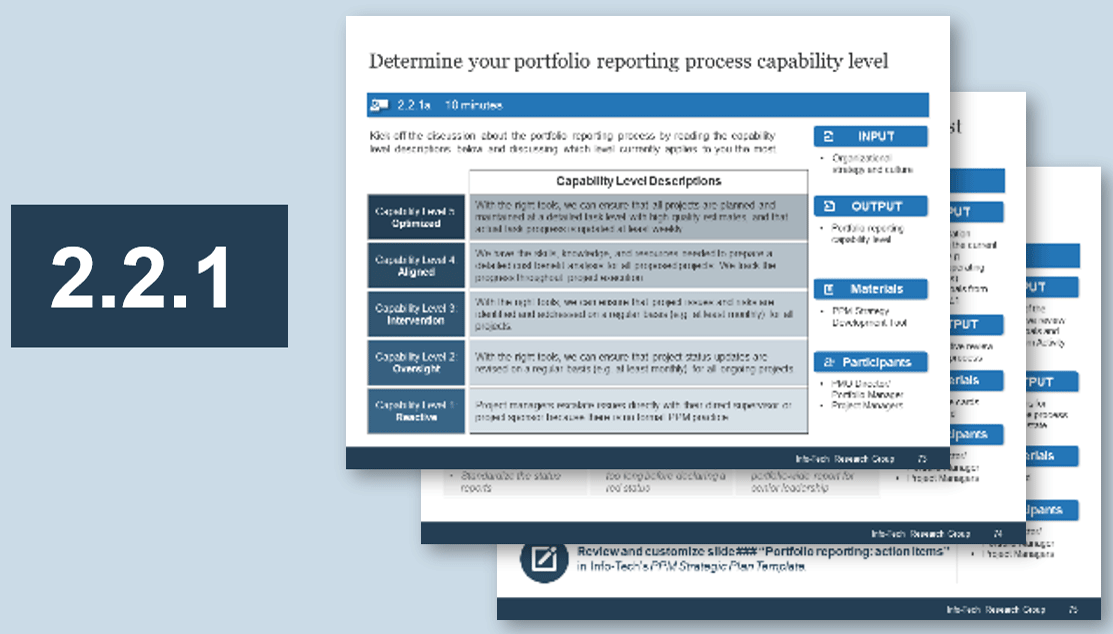 | Align your portfolio reporting process to the PPM strategy Examine the process at the current state and develop an action plan to improve it, with a high-level description of the process at a target state and its overhead costs. The outcome of this activity feeds into the overall PPM strategic plan. |
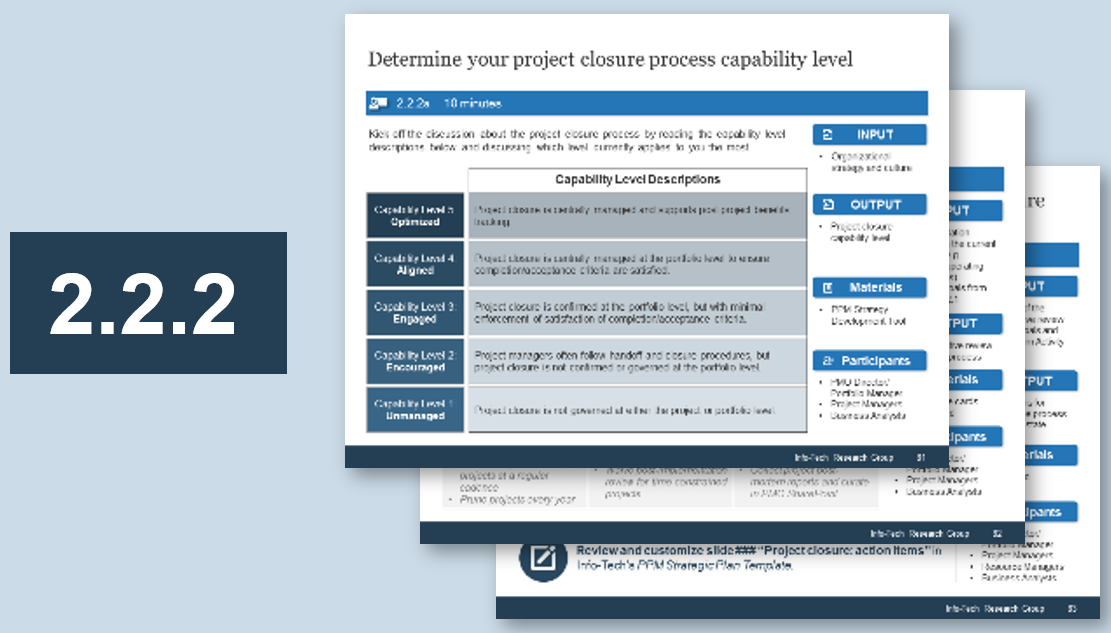 | Align your project closure process to the PPM strategy Examine the process at the current state and develop an action plan to improve it, with a high-level description of the process at a target state and its overhead costs. The outcome of this activity feeds into the overall PPM strategic plan. |
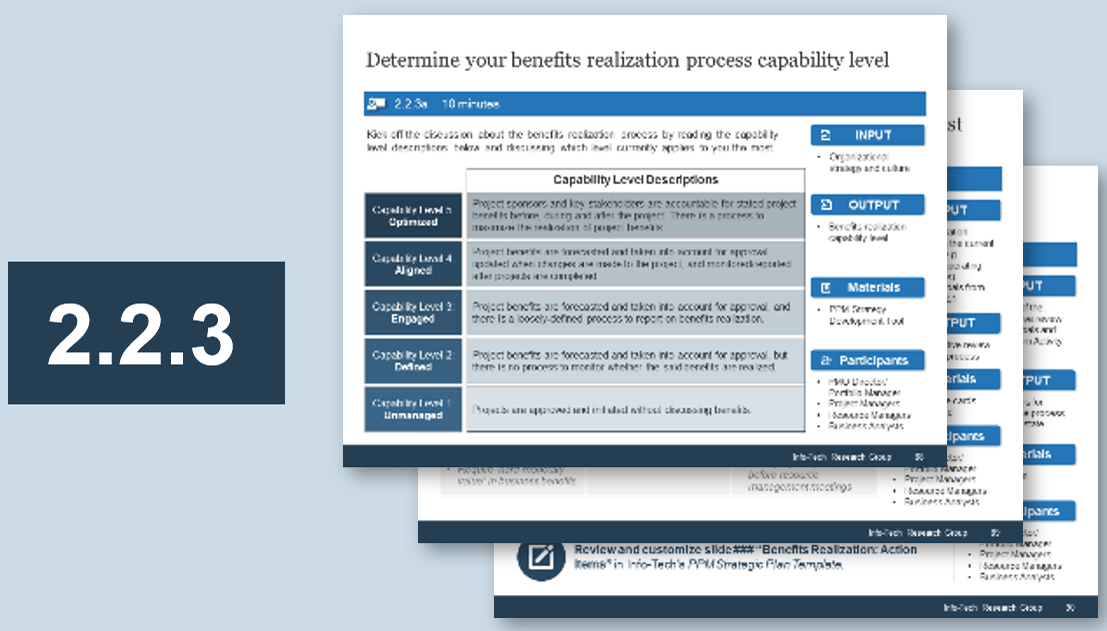 | Align your benefits realization process to the PPM strategy Examine the process at the current state and develop an action plan to improve it, with a high-level description of the process at a target state and its overhead costs. The outcome of this activity feeds into the overall PPM strategic plan. |
Develop a Project Portfolio Management Strategy
PHASE 3
Complete Your PPM Strategic Plan
Phase 2 outline
![]() Call 1-888-670-8889 or email GuidedImplementations@InfoTech.com for more information.
Call 1-888-670-8889 or email GuidedImplementations@InfoTech.com for more information.
Complete these steps on your own, or call us to complete a guided implementation. A guided implementation is a series of 2-3 advisory calls that help you execute each phase of a project. They are included in most advisory memberships.
Guided Implementation 3: Complete your PPM strategic plan
Proposed Time to Completion: 2 weeks
| Step 3.1: Select a right-sized PPM solution | Step 3.2: Finalize your PPM Strategic Plan Template |
Work with an analyst to:
| Review findings with analyst:
|
Then complete these activities…
| Then complete these activities…
|
With these tools & templates:
| With these tools & templates:
|
Phase 3 Insight:
| |
Step 3.1: Select a right-sized PPM solution for supporting your new processes
PHASE 1 | PHASE 2 | PHASE 3 | |||
| 1.1 | 1.2 | 2.1 | 2.2 | 3.1 | 3.2 |
| Choose the right PPM strategy | Translate strategy into process goals | Define intake & resource mgmt. processes | Define reporting, closure, & benefits mgmt. processes | Select a right-sized PPM solution | Finalize your PPM strategic plan |
This step will walk you through the following activities:
- Determine the functionality requirements of a PPM solution in the near and long terms.
- Estimate your PPM tool budget.
- Review tool assessment.
This step involves the following participants:
- CIO
- PMO Director/ Portfolio Manager
- Project Managers
- IT Managers
Outcomes of this step
- List of functional requirements for a PPM solution
- An estimate budget and cost for supporting a PPM tool in the near and long terms
- PPM tool requirements for the near and long terms
Right-size your PPM solution/tool to fit your PPM processes
Avoid a common pitfall: the disconnect between PPM processes and PPM tools.
PPM tools act as both a receptacle for portfolio data generated by your processes and a source of portfolio data to drive your processes forward. Therefore, choosing a suitable PPM tool is critical to the success of your PPM strategy:
- PPM tool inputs must match the type, level of detail, and amount of portfolio data generated by your PPM processes.
- PPM tool outputs must be useful, insightful, easy to access, and easy to understand for people who engage in your PPM processes.
User adoption is an often cited cause of failed PPM tool implementation:
"The biggest problem is getting the team to work with the tool. We need to make sure that we’re not wasting time delving too far down into the tool, yet putting enough information to get useful information back." (IT Director, Financial Services)
This final step of the blueprint will discuss the choice of PPM tools to ensure the success of PPM strategy by avoiding the process-tool disconnect.
Common pitfalls for PPM tools
- Purchasing and implementing a PPM tool before the process is defined and accepted.
- Poor expectation setting: inability of tools to perform the necessary analysis.
- Underleveraged: low user/process adoption.
- Poor integration with the corporate finance function. (WGroup, 2017)
Leverage PPM tools to get the information you need
An optimized PPM solution is the vehicle that provides decision makers with four key pieces of information they require when making decisions for your project portfolio:
- Historical Insight – inform decision makers about how much time and resources have been spent to date, and benchmark the accuracy of prior project estimates and resource allocations.
- Forecasting – provide a trustworthy estimate of demand on resources and current projects.
- Portfolio Analytics – analyze portfolio data and generate easy-to-consume reports that provide answers to questions such as:
- How big is our overall portfolio?
- How much money/resource time is available?
- How efficiently are we using our resources?
- Project Visibility – provide a trustworthy report on the status of current projects and the resources working on them.
Info-Tech Insight
Without the proper information, decision makers are driving blind and are forced to make gut feel decisions as opposed to data-informed decisions. Implement a PPM solution to allocate projects properly and ensure time and money don’t vanish without being accounted for.
Commercial PPM tools have more functionality but are more costly, complex, and difficult to adopt
|
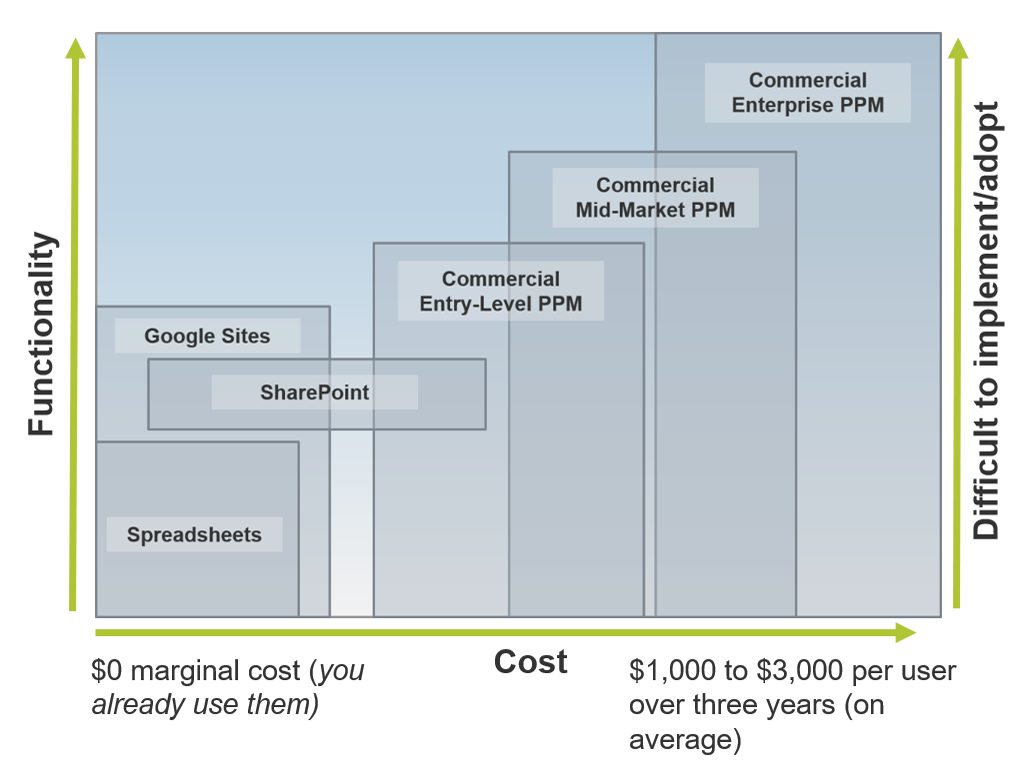 |
|
|
|
"Price tags [for PPM tools] vary considerably. Expensive products don't always provide more capability. Inexpensive products are generally low cost for good reason." (Merkhofer)
Your PPM tool options are not limited to commercial offerings
Despite the rapid growth in the commercial PPM tool market today, homegrown approaches like spreadsheets and intranet sites continue to be used as PPM tools.
Kinds of PPM solutions used by Info-Tech clients
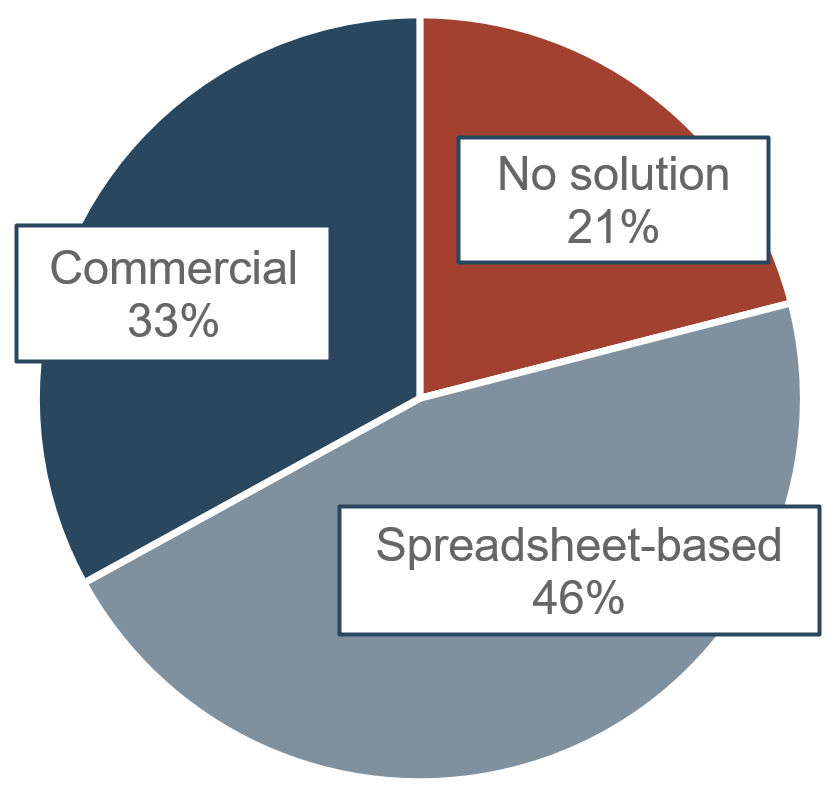 (Source: Info-Tech Research Group (2016), N=433)
(Source: Info-Tech Research Group (2016), N=433)
Category |
Characteristics |
PPM maturity |
| Enterprise tool |
|
High |
| Mid-market tool |
|
High |
| Entry-level tool |
|
Intermediate |
| Spreadsheet based |
|
Intermediate Low |
Determine the functional requirements of the PPM solution
![]() 3.1.1 – 20 minutes
3.1.1 – 20 minutes
INPUT: PPM strategic plan
OUTPUT: Modified PPM strategic plan with a proposed choice of PPM tool
Materials: PPM Strategy Development Tool
Participants: PMO Director/ Portfolio Manager, Project Managers, IT Managers
Use the Tool Assessment tab (tab 4) of Info-Tech’s PPM Strategy Development Tool to rate and analyze functional requirements of your PPM solution.
- Review the list of PPM features provided on column B of tab 4. You can add any desired features not listed.
- Rate your near-term and long-term feature requirements using the drop-down menus in columns C and D. Your selections here will inform the tool selection bubble chart to the right of the features list.
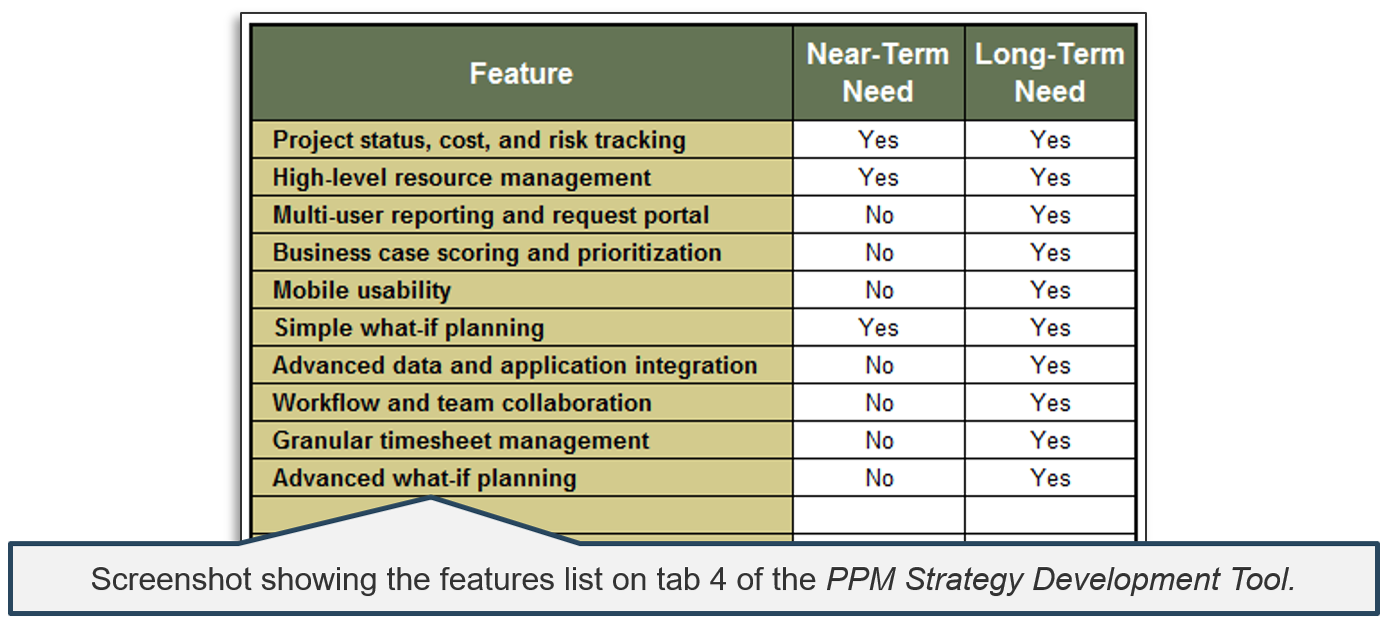
Estimate your PPM tool budget
![]() 3.1.2 – 20 minutes
3.1.2 – 20 minutes
INPUT: PPM strategic plan
OUTPUT: Modified PPM strategic plan with a proposed choice of PPM tool
Materials: PPM Strategy Development Tool
Participants: CIO, PMO Director/ Portfolio Manager, Project Managers, IT Managers
Enter the PPM tool budget information on the Tool Assessment tab of Info-Tech’s PPM Strategy Development Tool.
- As a starting point, it can help to know that low-priced PPM tools cost around $1,000 per user per year. High-priced PPM tools cost around $3,000 per user per year.
- Software-as-a-Service (SaaS)-based pricing for PPM solutions is increasingly popular. If you plan to purchase perpetual licensing, divide the total implementation and licensing cost by three years to be comparable with a three-year SaaS total cost of ownership analysis.
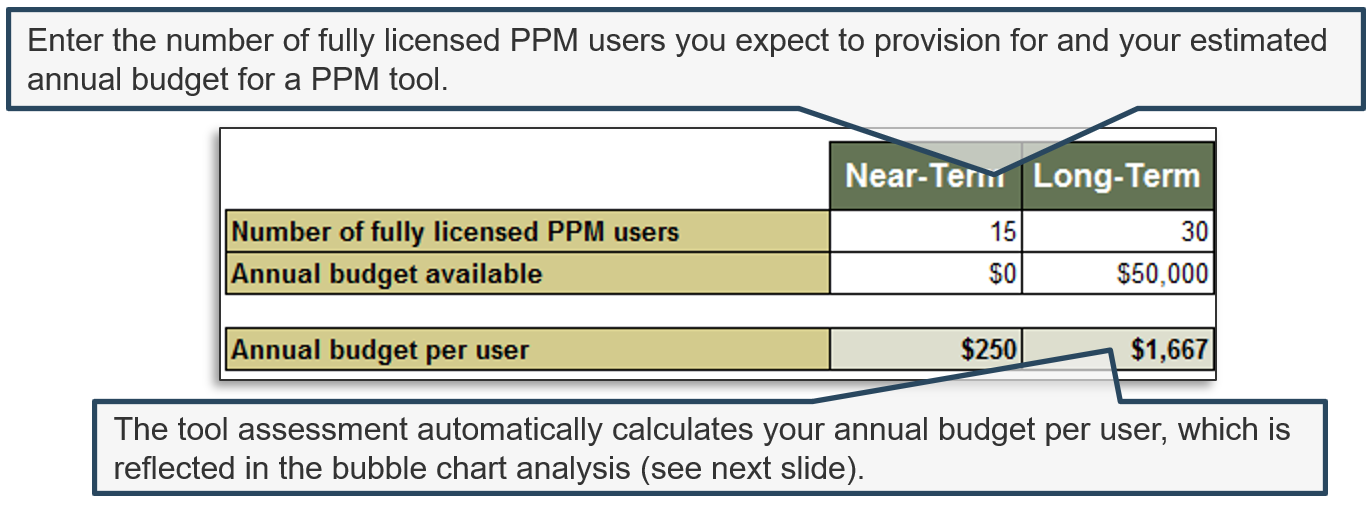
Review the tool assessment graphic
![]() 3.1.3 – 20 minutes
3.1.3 – 20 minutes
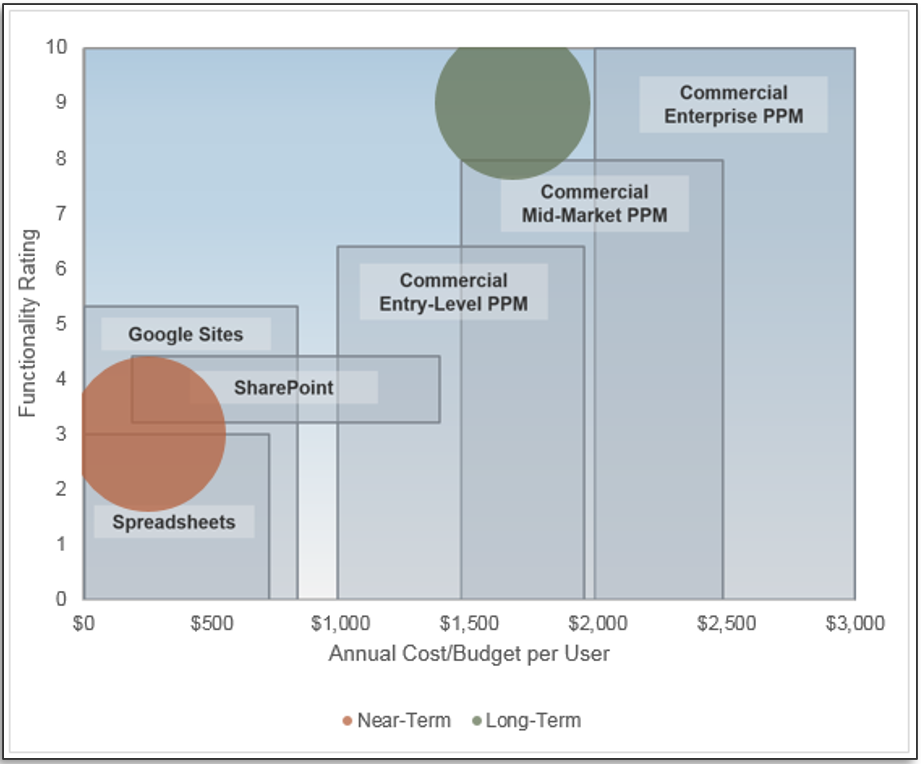
If you are in one of the non-covered areas, consider revisiting your functional requirements and PPM strategy. You may need to lessen your expectations to be able to stay within your budget, or find a way to get more money.
Keep in mind that the long-term goal can be to work towards a commercial tool, while the short-term goal would be to be able to maintain your portfolio in a simple spreadsheet first.
Info-Tech Insight
If you choose a commercial solution, you will need to gain executive buy-in in order to implement the tool; proceed to near-term and long-term plans to get the ball rolling on this decision.
Review and customize slide 37, “Tools for PPM: proposed near- and long-term solutions,” in Info-Tech’s PPM Strategic Plan Template.
Grow your own, or select and implement, a PPM solution with Info-Tech
Whether you choose spreadsheet-based or commercially available PPM solutions, use Info-Tech’s research for scoping, designing, and implementing them.
Info-Tech’s Grow Your Own PPM Solution blueprint will help you implement a highly evolved spreadsheet-based PPM solution. It features the Portfolio Manager 2017, a Microsoft Excel-based workbook that leverages its business intelligence features to provide a basis for implementing a scalable, highly customizable PPM tool with useful and easy-to-manipulate analytics.
Read Info-Tech’s Grow Your Own PPM Solution blueprint.
Info-Tech’s Select and Implement a PPM Solution blueprint is part of our Vendor Landscape research. Make sense of the diversity of PPM solutions available in today’s market, and choose the most appropriate solutions for your organization’s size and level of PPM maturity.
Read Info-Tech’s Select and Implement a PPM Solution blueprint.
A right-sized PPM strategy leads to a right-sized portfolio management tool based on Info-Tech’s template
CASE STUDY
Industry: Energy
Source: Info-Tech Client
“The approach makes it easy to run the portfolio without taking time away from the project themselves.” (IT Manager, Energy Resources Firm)
Situation
- A small IT department struggled with balancing project work with ongoing operational management and support work.
- The department includes experienced and successful project managers and a mature, skilled team.
- However, the nature of the department’s role has evolved to the point where the project and operational work demands have exceeded the available time.
- Prioritization needed to become more centralized and formalized while management control of the work assignments became increasingly decentralized.
Complication
- Agile projects offer clear advantages by lightening the requirement for proactive planning. However, getting the staff to adapt would be challenging because of the overall workload and competing priorities.
- Some of the team’s time needed to be carefully tracked and reported for time & materials-based billing, but the time sheet system was unsuited to their portfolio management needs.
- Commercial PPM systems were ruled out because strict task management seemed unlikely to gain adoption.
Resolution
- The team deployed Info-Tech’s Project Portfolio Workbook, based on a Microsoft Excel template, and the Grow Your Own PPM Solution blueprint.
- For the first time, executive leadership was given a 12-month forecast of resource capacity based on existing and pending project commitments. The data behind the capacity forecast was based on allocating people to projects with a percentage of their time for each calendar month.
- The data behind the forecast is high level but easily maintainable.
Step 3.2: Finalize customizing your PPM Strategic Plan Template
PHASE 1 | PHASE 2 | PHASE 3 | |||
| 1.1 | 1.2 | 2.1 | 2.2 | 3.1 | 3.2 |
| Choose the right PPM strategy | Translate strategy into process goals | Define intake & resource mgmt. processes | Define reporting, closure, & benefits mgmt. processes | Select a right-sized PPM solution | Finalize your PPM strategic plan |
This step will walk you through the following activities:
- Determine the costs of support your PPM strategic plan.
- Estimate some of the benefits of your PPM strategic plan.
- Perform a cost-benefit analysis.
- Refine and consolidate the near-term action items into a cohesive plan.
This step involves the following participants:
- CIO
- PMO Director/ Portfolio Manager
- Project Managers
- IT Managers
Outcomes of this step
- A cost/benefit analyst
- An implementation action plan
- A finalized PPM Strategic Plan Template
Estimate the total cost-in-use of managing the project portfolio
The time cost of PPM processes (tab 3) and PPM tool costs (tab 4) are summarized in this tab. Enter additional data to estimate the total PPM cost-in-use: the setup information and the current cost of PPM software tools.
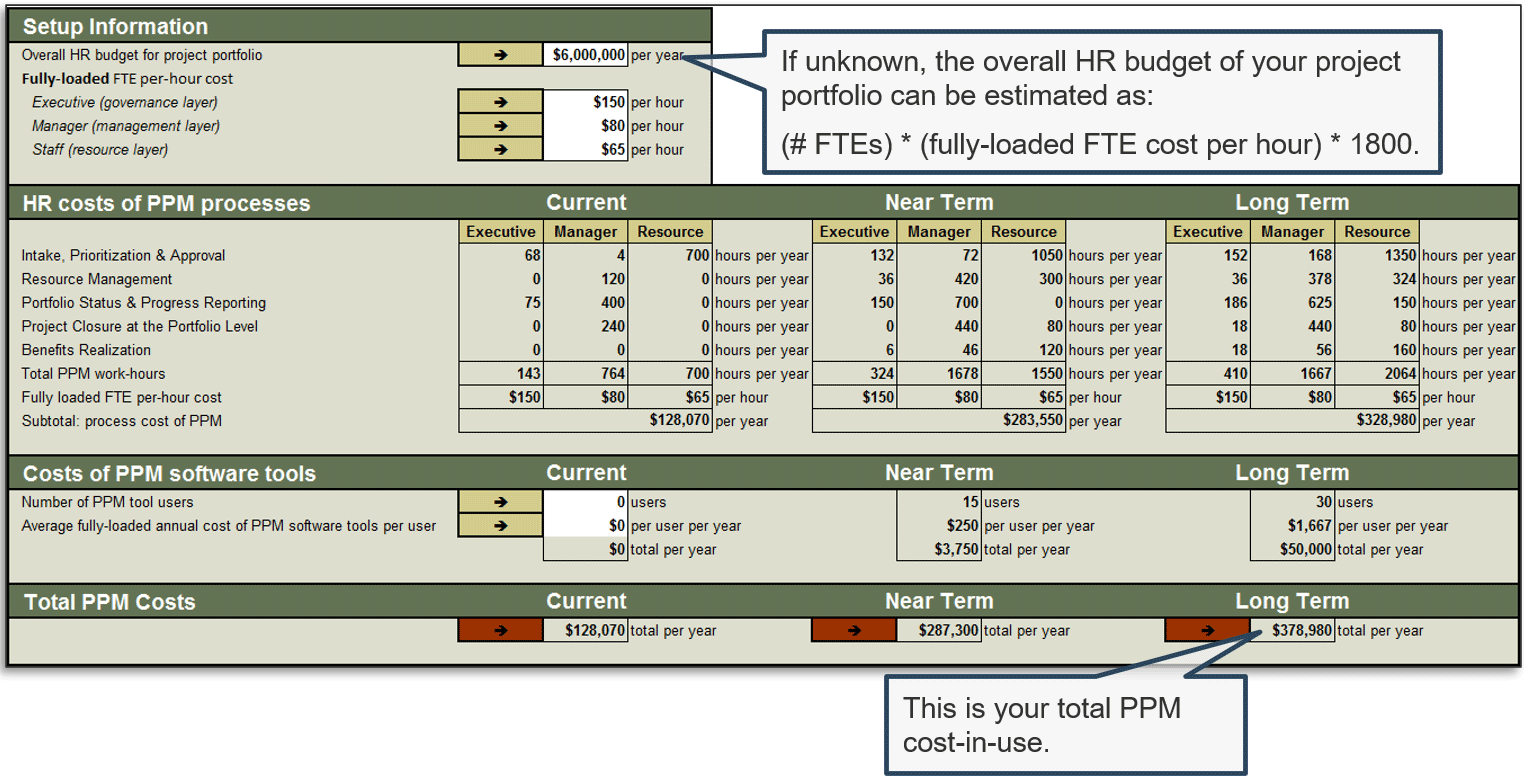
Estimate the benefits of managing the project portfolio
The benefits of PPM processes are estimated by projecting the sources of waste on your resource capacity.
- Estimate the current extent of waste on your resource capacity. If you have completed Info-Tech’s PPM Current Score Scorecard, enter the data from the report.
- Given your near- and long-term action items for improving PPM processes, estimate how each source of waste on your resource capacity will change.


Review the cost-benefit analysis results and update the PPM Strategic Plan Template
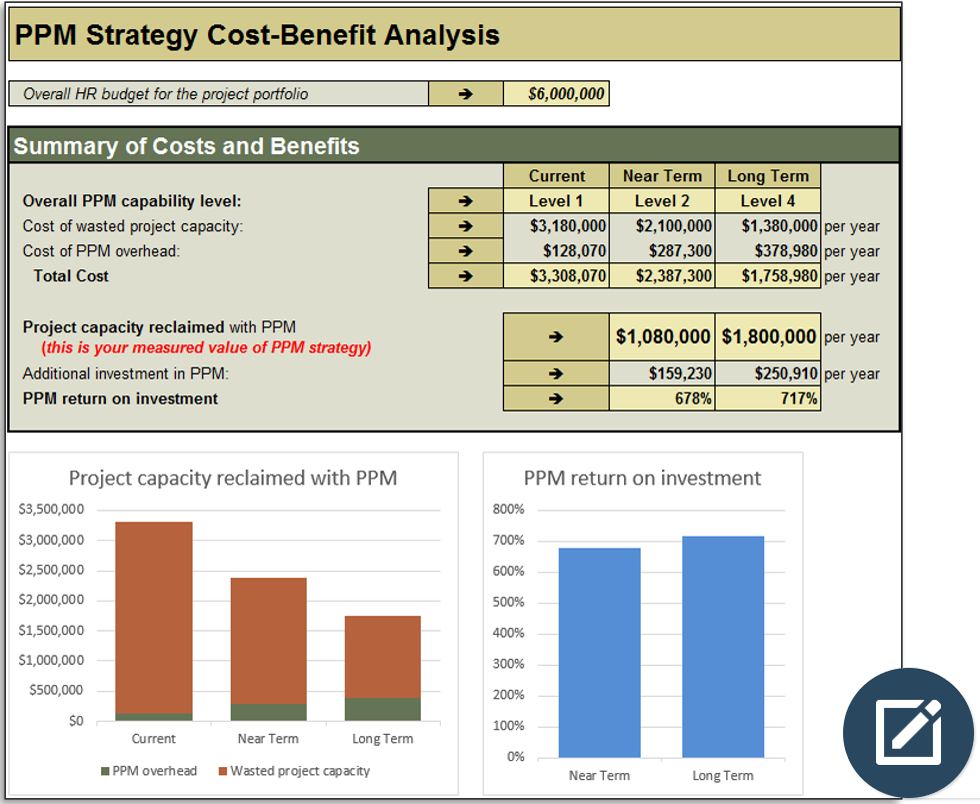
This tab summarizes the costs and benefits of your PPM strategic plan.
- Costs are estimated from wasted project capacity and time spent on PPM process work.
- Benefits are estimated from the project capacity to be reclaimed as a result of improvements in PPM.
- Return on investment is calculated by dividing the value of project capacity to be reclaimed by investment in PPM in addition to the current-state cost.
Capture this summary in your PPM strategic plan.
Customize slides 40 and 41, “Return on PPM investment,” in Info-Tech’s PPM Strategic Plan Template.
Determine who will be responsible for coordinating the flow, collection, and reporting of portfolio data
You will need to determine responsibilities and accountabilities for portfolio management functions within your team.
If you do not have a clearly identifiable portfolio manager at this time, you will need to clarify who will wear which hats in terms of facilitating intake and prioritization, high-level capacity awareness, and portfolio reporting.
- Use Info-Tech’s Project Portfolio Analyst Job Description Template to help clarify some of the required responsibilities to support your PPM strategy.
- If you need to bring in an additional staff member to help support the strategy, you can customize the job description template to help advertise the position. Simply edit the text in grey within the template.
- If you have other PPM tasks that you need to define responsibilities for, you can use the RASCI chart on the final tab of the PPM Strategy Develop Tool.
Download Info-Tech’s Project Portfolio Analyst Job Description Template.
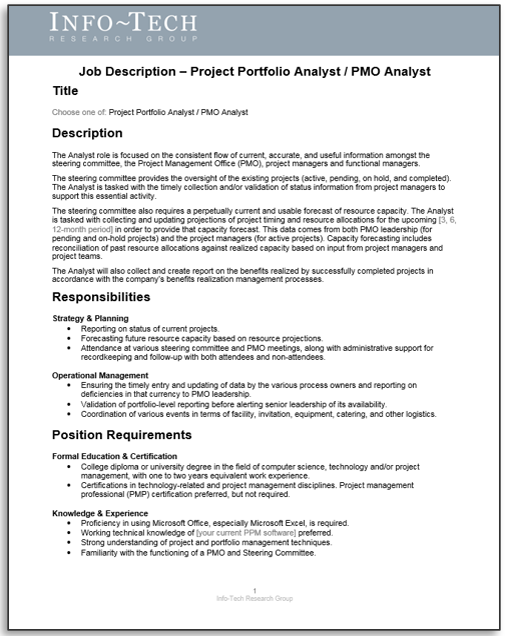
Refine and consolidate the near-term action items into a cohesive plan
![]() 3.2.4 – 30 minutes
3.2.4 – 30 minutes
INPUT: Near-term action items
OUTPUT: Near-term action plan
Materials: PPM Strategy Development Tool
Participants: PMO Director/ Portfolio Manager, Project Managers, Resource Managers, Business Analysts
Collect the near-term action items for each of the five PPM processes and arrange them into a table that outlines the near-term action plan. Once it is compiled, adjust the timeline and responsibility so that the plan is coherent and realistic as a whole.
Example:
Outcome |
Action required |
Timeline |
Responsibility |
| Determine the percentage distribution of project vs. non-project work | Run a time audit survey with all project resources | 2 weeks | Resource managers |
| Test a simple dashboard for project status | Pilot Info-Tech’s Portfolio Manager 2017 workbook | 2 weeks | PMO Director |
"There is a huge risk of taking on too much too soon, especially with the introduction of specific tools and tool sets. There is also an element of risk involved that can lead to failure and disappointment with PPM if these tools are not properly introduced and supported." (Jim Carse, Director of the Portfolio Office, Queen’s University)
Review and customize slide 43, “Summary of near-term action plan,” in Info-Tech’s PPM Strategic Plan Template.
Finalize and publish your PPM strategic plan
Table of Contents |
Read over the document to ensure its completeness and consistency.At this point, you have a PPM strategic plan that is actionable and realistic, which addresses the goals set by the senior leadership. The executive brief establishes the need for PPM strategy, the goals and metrics are set by members of the senior leadership that gave the initial buy-in, and the target states of PPM processes that meet those goals are described. Finally, the costs and benefits of the improved PPM practice are laid out in a way that can be validated. The next step for your PPM strategy is to use this document as a foundation for implementing and operationalizing the target-state PPM processes.Review and publish the document for your executive layer and key project stakeholders. Solicit their feedback. Info-Tech has a library of blueprints that will guide you through each of the five processes. Contact your Info-Tech account manager or Info-Tech analyst to get started. |
|
If you want additional support, have our analysts guide you through this phase as part of an Info-Tech Workshop 
Book a workshop with our Info-Tech analysts:
 |
|
The following are sample activities that will be conducted by Info-Tech analysts with your team:
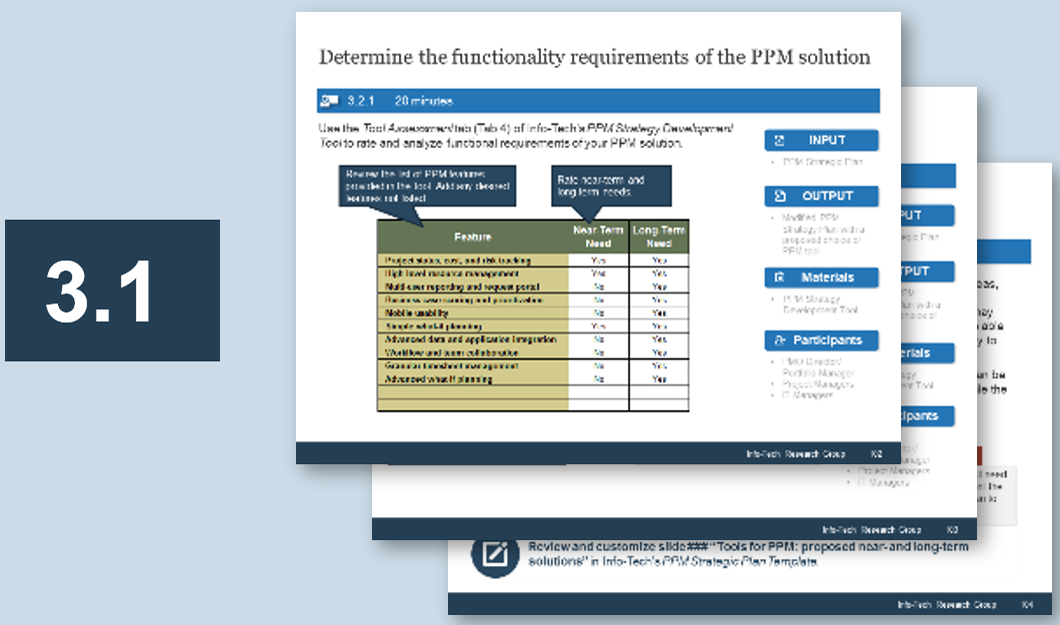 |
Scope the right-sized PPM solution for your PPM strategy
Use the PPM Strategy Development Tool to quickly determine our near- and long-term recommendation for your PPM solution. |
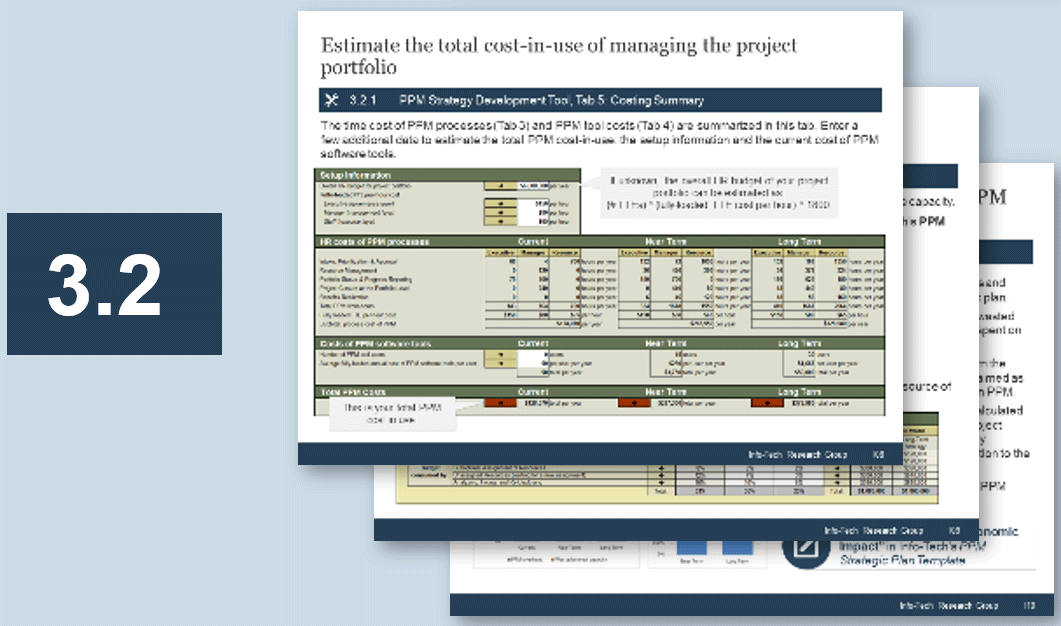 |
Conduct a cost-benefit analysis of your PPM strategic plan
Using the time cost estimates of each process and the requirement for a PPM tool, Info-Tech helps you quantify the overhead costs of PPM and estimate the monetary benefits of reclaimed project capacity for your project portfolio. |
Insight breakdown
Insight 1
- Executive layer buy-in is a critical prerequisite for the success of a top-down PPM strategy. Ensure your executives are on board before preceding to implement your PPM strategy.
Insight 2
- The means of project and portfolio management (i.e. processes) shouldn’t eclipse the ends – strategic goals. Root your process in your PPM strategic goals to realize PPM benefits (e.g. optimized portfolio value, improved project throughput, increased stakeholder satisfaction).
Insight 3
- Without the proper information, decision makers are driving blind and are forced to make gut-feel decisions as opposed to data-informed decisions. Implement a PPM solution to allocate projects properly and ensure time and money don’t vanish without being accounted for.
Summary of accomplishment
Knowledge Gained
- Info-Tech’s thought model on PPM processes that create an infrastructure around projects
- Your current state of project portfolio: project capacity vs. project demand
- Importance of gaining executive buy-in for installing the PPM practice
Processes Optimized
- Project intake, prioritization, and approval process
- Resource management process
- Portfolio reporting process
- Project closure process
- Benefits realization process
Deliverables Completed
- Choice of PPM strategy and the leadership mandate
- Analysis of current project capacity and demand
- PPM process goals and metrics, aligned to meet PPM strategic expectations
- PPM process capability levels
- Retrospective examination of current state, near/long-term action items for improvement, and high-level descriptions of the five PPM processes
- Recommendation of PPM tools to support the processes
- Estimate of PPM overhead costs
- Cost-benefit analysis of PPM practice
- PPM strategic plan
Related Info-Tech Research
- Develop a Project Portfolio Management Strategy
- Grow Your Own PPM Solution
- Optimize Project Intake, Approval, and Prioritization
- Develop a Resource Management Strategy for the New Reality
- Manage a Minimum-Viable PMO
- Establish the Benefits Realization Process
- Manage an Agile Portfolio
- Establish the Benefits Realization Process
- Project Portfolio Management Diagnostic Program
The Project Portfolio Management Diagnostic Program is a low-effort, high-impact program designed to help project owners assess and improve their PPM practices. Gather and report on all aspects of your PPM environment in order to understand where you stand and how you can improve.
Research contributors and experts
 |
Kiron D. Bondale PMP, PMI-RMP, CDAP, CDAI Senior Project Portfolio Management Professional Kiron has worked in the project management domain for more than fifteen years managing multiple projects, leading Project Management Offices (PMO) and providing project portfolio management consulting services to over a hundred clients across multiple industries. He has been an active member of the Project Management Institute (PMI) since 1999 and served as a volunteer director on the Board of the PMI Lakeshore Chapter for six years. Kiron has published articles on project and project portfolio management in multiple journals and has delivered over a hundred webinar presentations on a variety of PPM and PM topics and has presented at multiple industry conferences. Since 2009, Kiron has been blogging on a weekly basis on project management topics and responds to questions daily in the LinkedIn PMI Project, Program and Portfolio Management discussion group. |
 |
Shaun Cahill, Project Manager & Jim Carse, Director of the Project Portfolio Office Queen’s University |
Research contributors and experts
 |
Amy Fowler Stadler, Managing Partner Lewis Fowler Amy has more than 20 years of experience in business and technology, most recently owning her own management consulting firm since 2002, focused on business transformation, technology enablement, and operational improvement. Prior to that, she was at CenturyLink (formerly Qwest) as an IT Director, Perot Systems in various roles, and Information Handling Services, Inc. as a Software Development Product Manager. Amy holds a bachelor’s degree in Computer Science with a minor in Business Communications and is also a 2015 Hall of Fame inductee to Illinois State University College of Applied Science and Technology. |
 |
Rick Morris, President R2 Consulting LLC Rick A. Morris, PMP, is a certified Scrum Agile Master, Human Behavior Consultant, best-selling author, mentor, and evangelist for project management. Rick is an accomplished project manager and public speaker. His appetite for knowledge and passion for the profession makes him an internationally sought after speaker delivering keynote presentations for large conferences and PMI events around the world. He holds the PMP (Project Management Professional), MPM (Masters of Project Management), Scrum Agile Master, OPM3, Six Sigma Green Belt, MCITP, MCTS, MCSE, TQM, ATM-S, ITIL, and ISO certifications, and is a John Maxwell Certified Speaker, Mentor, and Coach. Rick is the Owner of R2 Consulting, LLC and has worked for organizations such as GE, Xerox, and CA, and has consulted with numerous clients in a wide variety of industries including financial services, entertainment, construction, non-profit, hospitality, pharmaceutical, retail, and manufacturing. |
Research contributors and experts
 |
Terry Lee Ricci PgMP, PfMP, PMP, PPM Practice Lead IAG Consulting Terry is passionate and highly skilled at PMO transformation, developing high-performing teams that sustain long-term business results. Terry has a reputation built upon integrity, resourcefulness, and respect. She has the vision to implement long and short-term strategies, meeting both current and evolving business needs. Change Management/Business transformation: Terry has extensive background in PMO strategy development aligned to corporate goals. Many years in the PMO organization integration/transformation building or overhauling programs and processes. Governance: Terry loves to monitor and measure performance and outcomes and uses her collaborative style to successfully bring simplicity to complexity (technology – people – process). Performance optimization results are easy to use and clearly define who is doing what across functions. End results consistently align to business strategy while mitigating risks effectively. Comprehensive: A “through the ranks” executive with a comprehensive understanding of PMO operations, high-performance teams, and the respective business units they support. |
 |
Alana Ruckstuhl MSc, IT Project Officer Federal Economic Development Agency for Southern Ontario |
Research contributors and experts
 |
Jay Wardle, Director of the PMO Red Wing Shoes Co. |
 |
Bob White, Vice President/Chief Information Officer ALM Holding Company As vice president and chief information officer for ALM Holding Company, Bob White directs all technology activity and support for three main verticals: road construction, energy management, and delivery and transportation. He has been with ALM Holding Company for one and a half years, focusing on PPM process improvement, cybersecurity initiatives, and IT service management. Prior to joining ALM, Bob was executive vice president/chief information officer at Ashley Furniture Industries, Inc. where he led the strategic direction, implementation, and management of information technology throughout the company’s global operations. Bob has also held VP/CIO positions at the Stride Rite Corporation and Timex Corporation. Bob holds a Master’s degree in Operations Management from the University of Arkansas and a Bachelor of Science degree in Industrial Engineering from Southern Illinois University. |
Bibliography
Bersin, Josh. “Time to Scrap Performance Appraisals?” Forbes Magazine, 5 June 2013. Web. 30 Oct 2013.
Cheese, Peter et al. “Creating an Agile Organization.” Accenture, Oct. 2009. Web. Nov. 2013.
Croxon, Bruce et al. “Dinner Series: Performance Management with Bruce Croxon from CBC's 'Dragon's Den'” HRPA Toronto Chapter. Sheraton Hotel, Toronto, ON. 12 Nov. 2013. Panel discussion.
Culbert, Samuel. “10 Reasons to Get Rid of Performance Reviews.” Huffington Post Business, 18 Dec. 2012. Web. 28 Oct. 2013.
Denning, Steve. “The Case Against Agile: Ten Perennial Management Objections.” Forbes Magazine, 17 Apr. 2012. Web. Nov. 2013.
Estis, Ryan. “Blowing up the Performance Review: Interview with Adobe’s Donna Morris.” Ryan Estis & Associates, 17 June 2013. Web. Oct. 2013.
Gallup, Inc. “Gallup Study: Engaged Employees Inspire Company Innovation.” Gallup Management Journal, 12 Oct. 2006. Web. 12 Jan 2012.
Gartside, David et al. “Trends Reshaping the Future of HR.” Accenture, 2013. Web. 5 Nov. 2013.
KeyedIn Solutions. “Why PPM and PMOs Fail.” KeyedIn Projects, 2013. Ebook.
Lessing, Lawrence. Free Culture. Lulu Press Inc.: 30 July 2016.
Merkhofer, Lee. “Keys to Implementing Project Portfolio Management.” Lee Merkhofer Consulting, 2017.
Perry, Mark Price. Business Driven Project Portfolio Management. J Ross Pub: 17 May 2011.
Project Management Institute. “Pulse of the Profession 2015: Capturing the Value of Project Management.” PMI, Feb. 2015. Web.
Project Management Institute. “Pulse of the Profession 2016: The High Cost of Low Performance.” PMI, 2016. Web.
Project Management Institute. “Pulse of the Profession 2017: Success Rates Rise.” PMI, 2017. Web.
Project Management Institute. The Standard for Portfolio Management – Third Edition. PMI: 1 Dec. 2012.
WGroup. “Common Pitfalls in Project Portfolio Management – Part 2.” WGroup, 24 Jan. 2017. Web.
Buying Options
Develop a Project Portfolio Management Strategy
Client rating
Cost Savings
Days Saved
IT Risk Management · IT Leadership & Strategy implementation · Operational Management · Service Delivery · Organizational Management · Process Improvements · ITIL, CORM, Agile · Cost Control · Business Process Analysis · Technology Development · Project Implementation · International Coordination · In & Outsourcing · Customer Care · Multilingual: Dutch, English, French, German, Japanese · Entrepreneur
Tymans Group is a brand by Gert Taeymans BV
Gert Taeymans bv
Europe: Koning Albertstraat 136, 2070 Burcht, Belgium — VAT No: BE0685.974.694 — phone: +32 (0) 468.142.754
USA: 4023 KENNETT PIKE, SUITE 751, GREENVILLE, DE 19807 — Phone: 1-917-473-8669
Copyright 2017-2022 Gert Taeymans BV